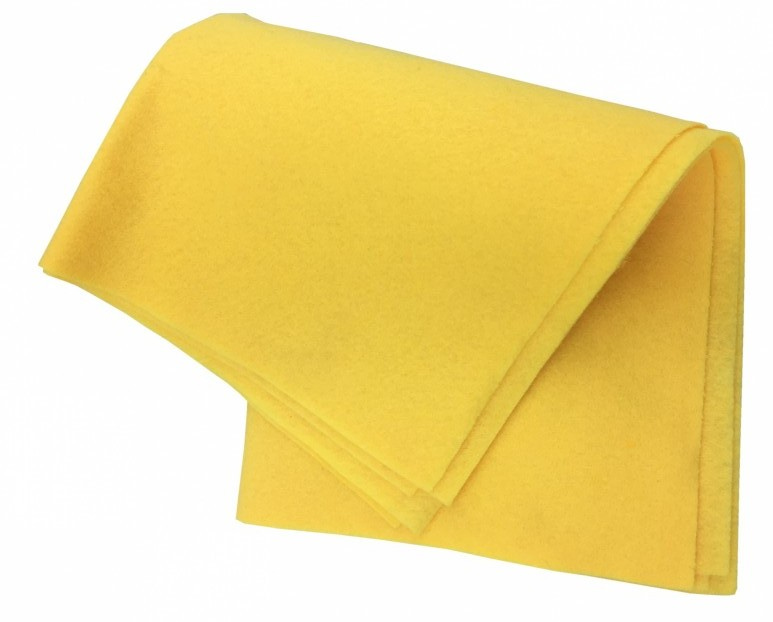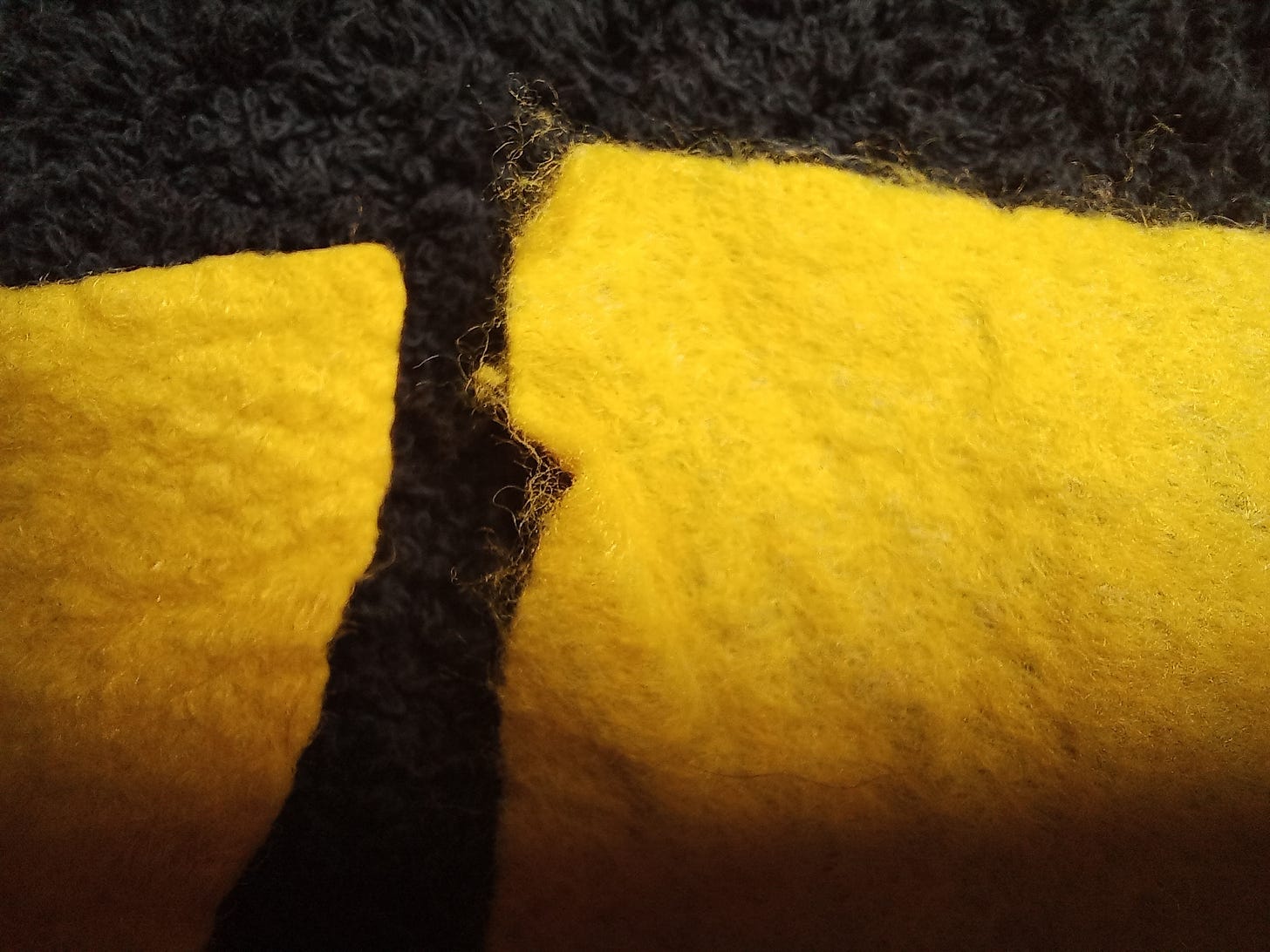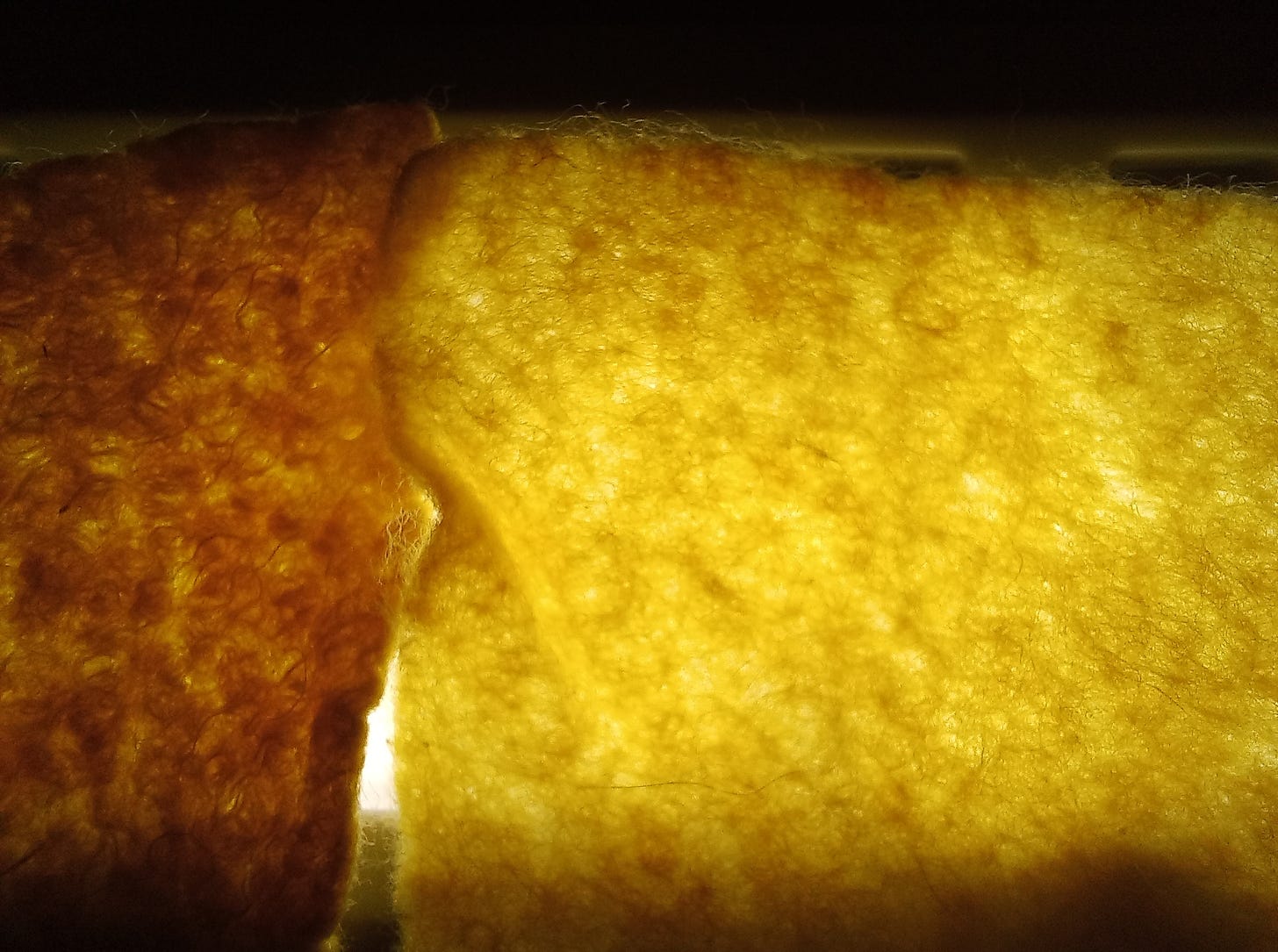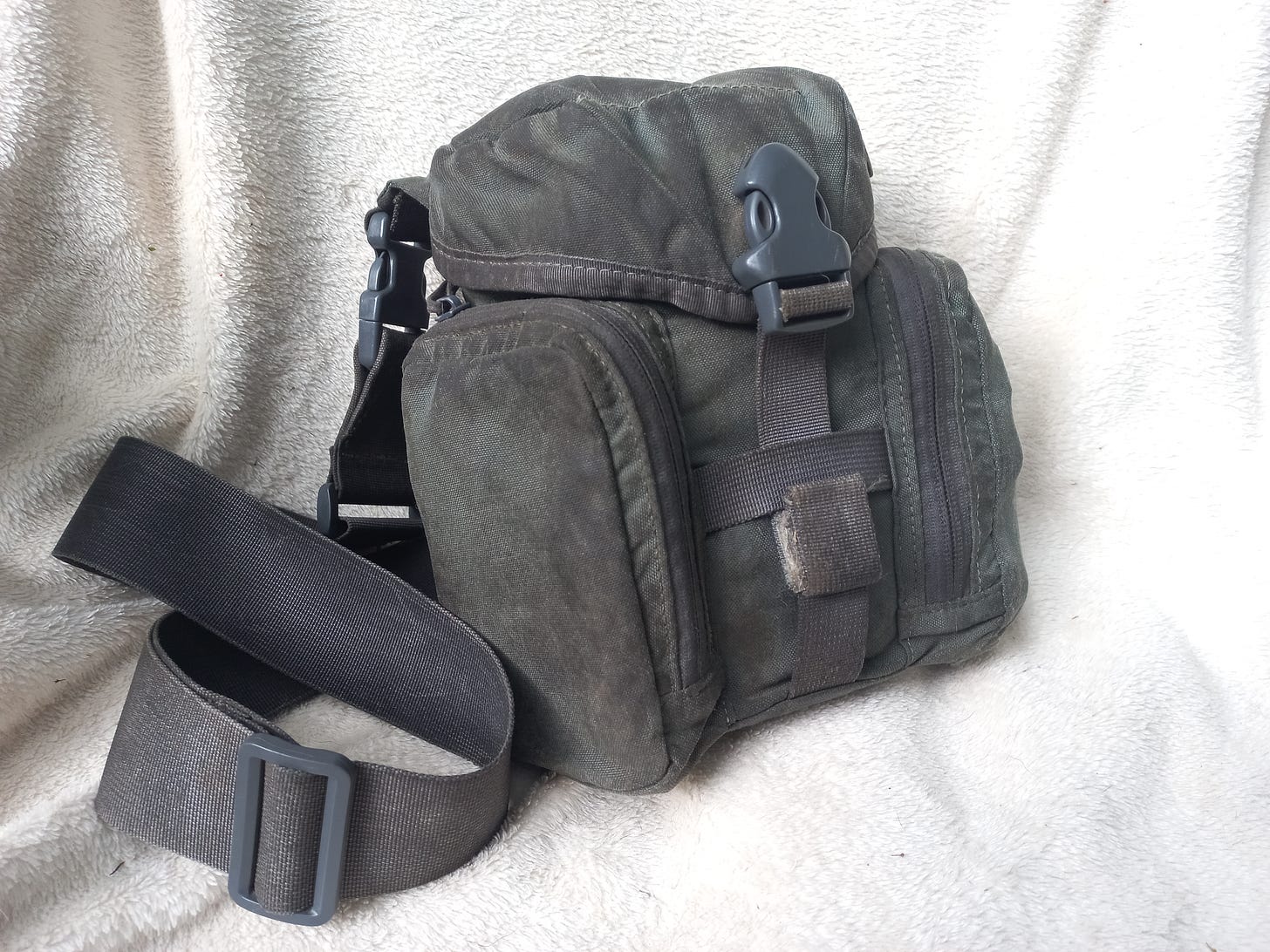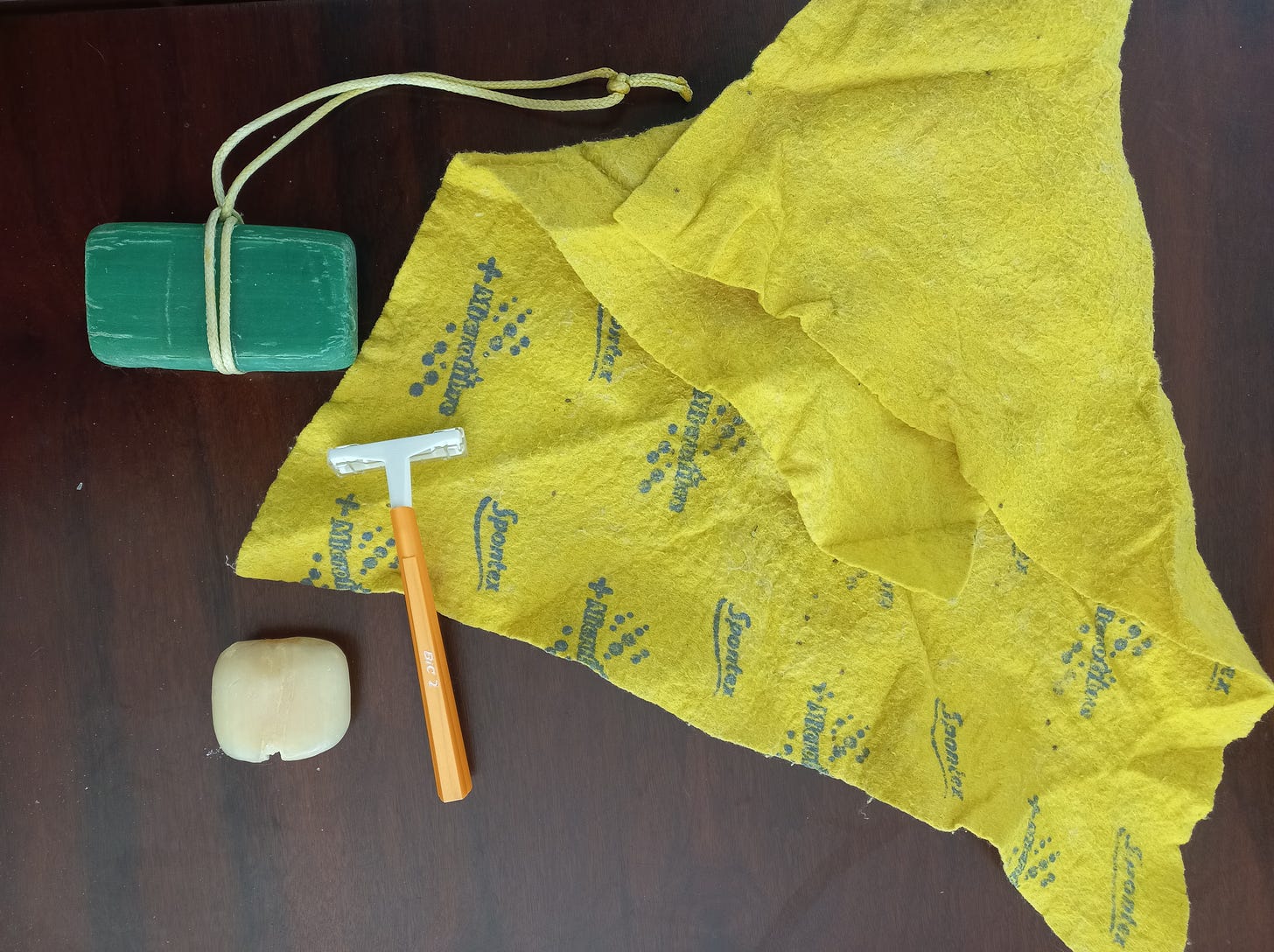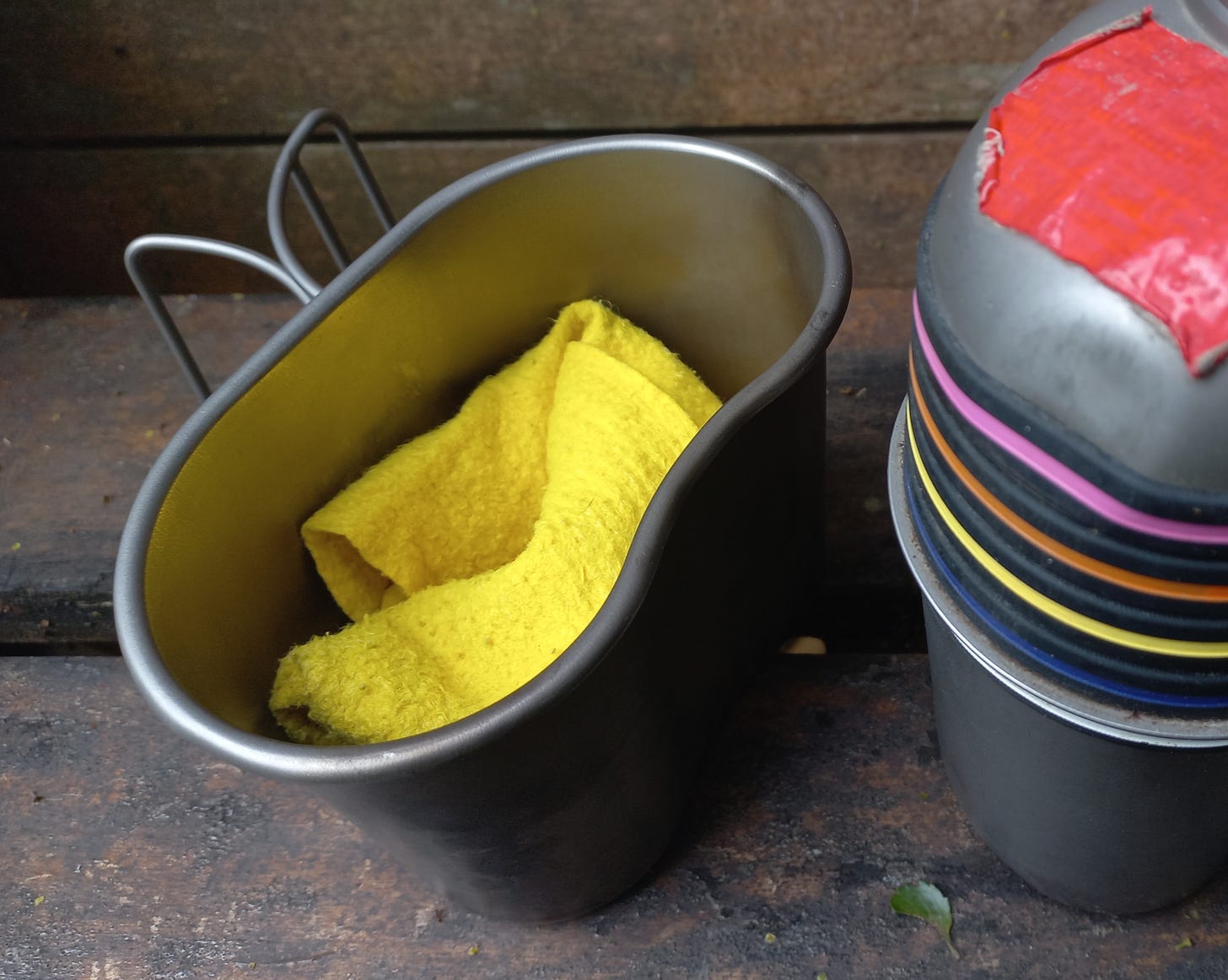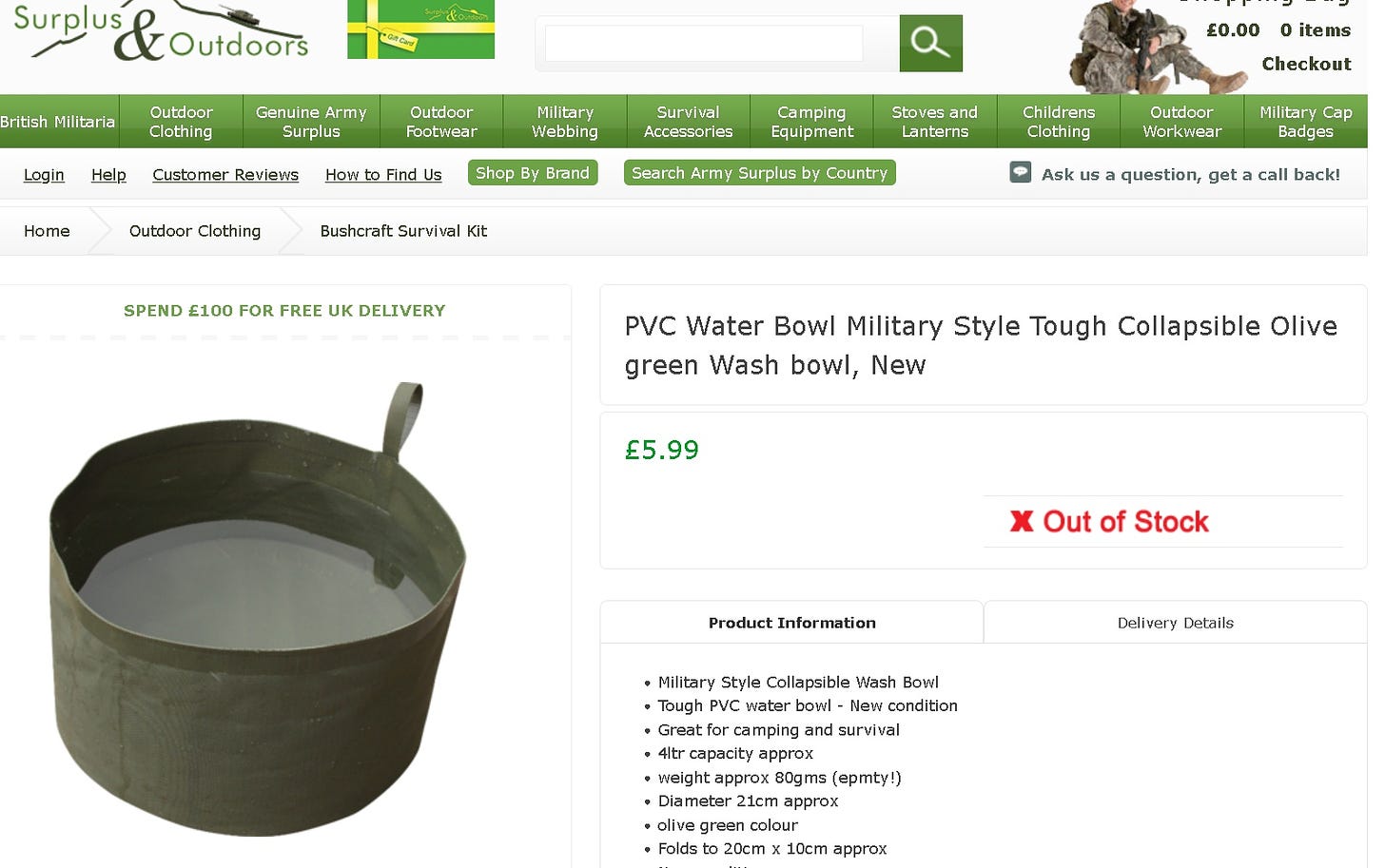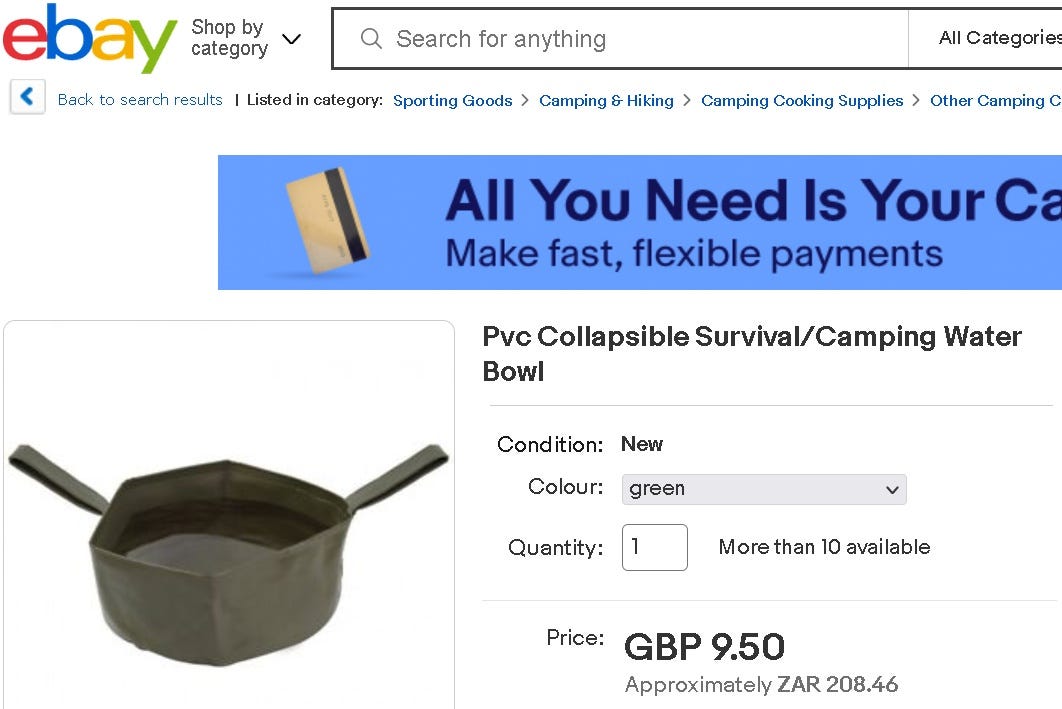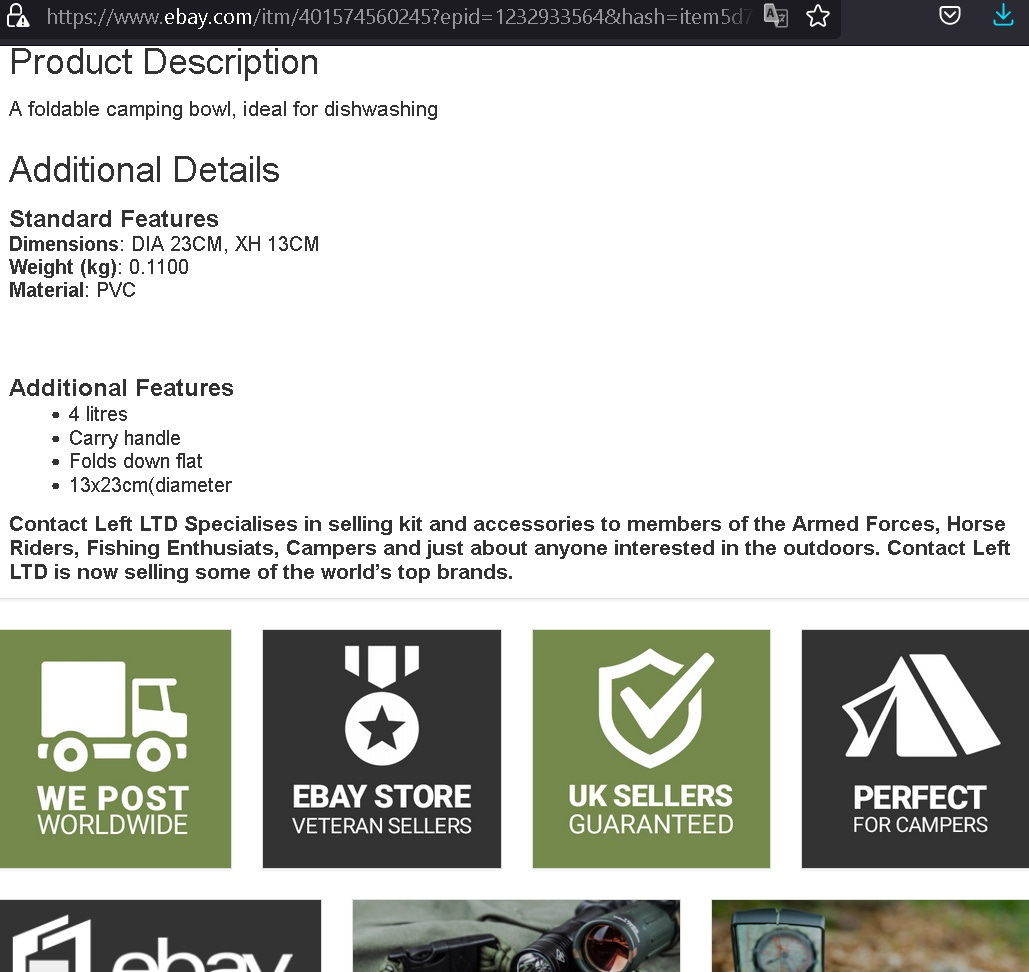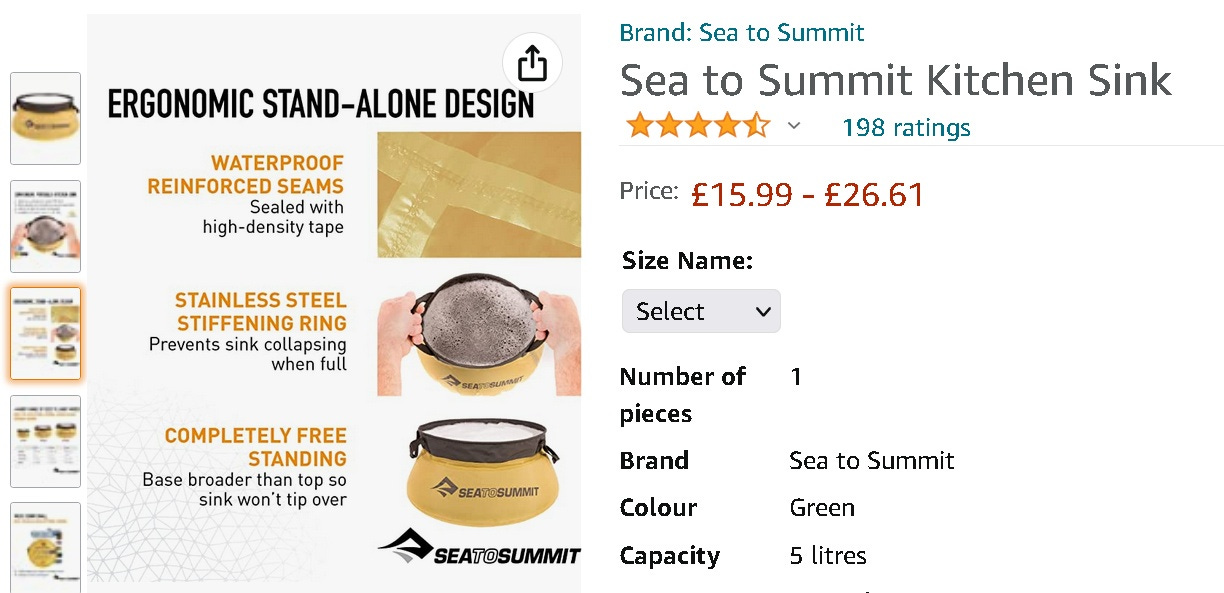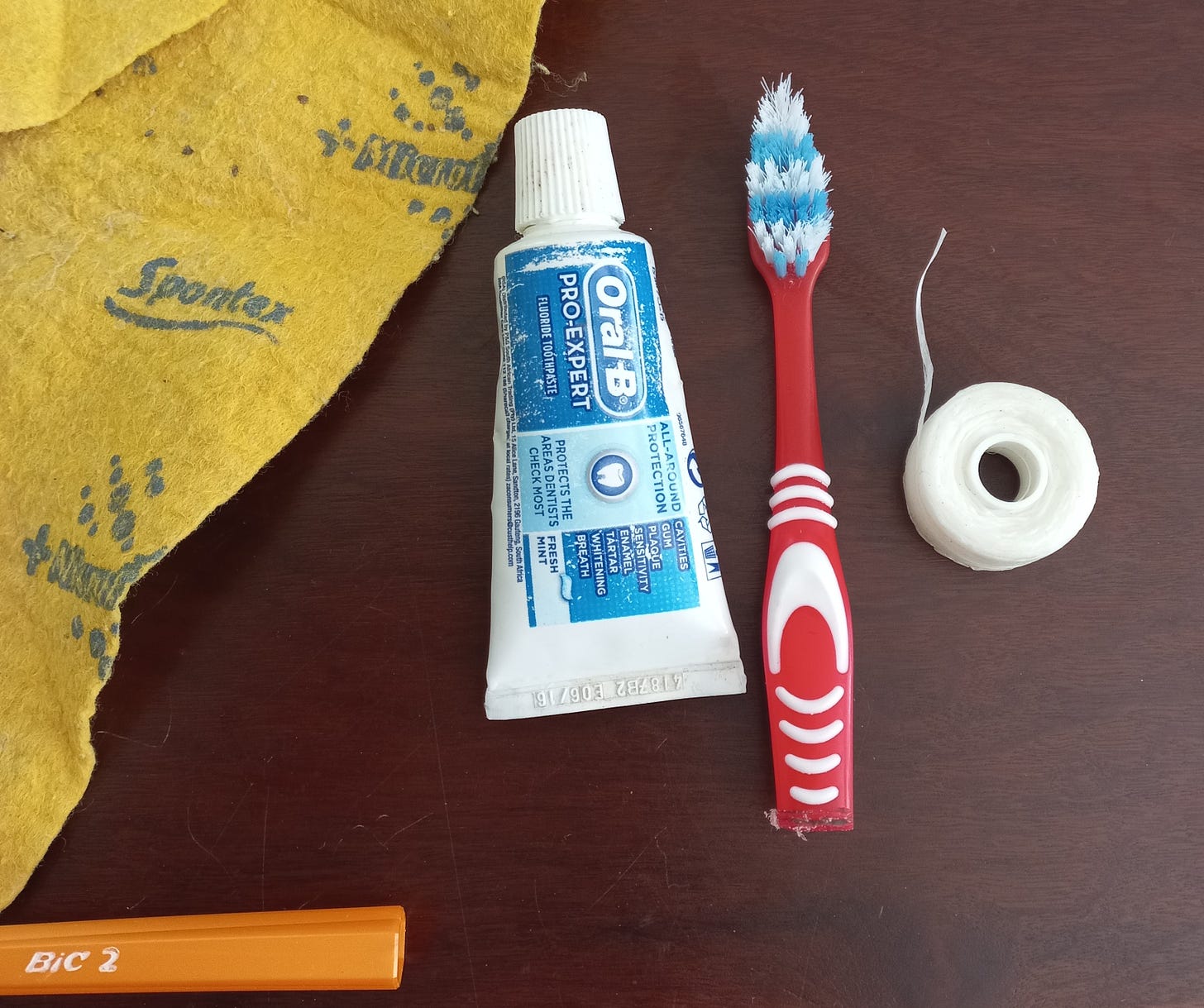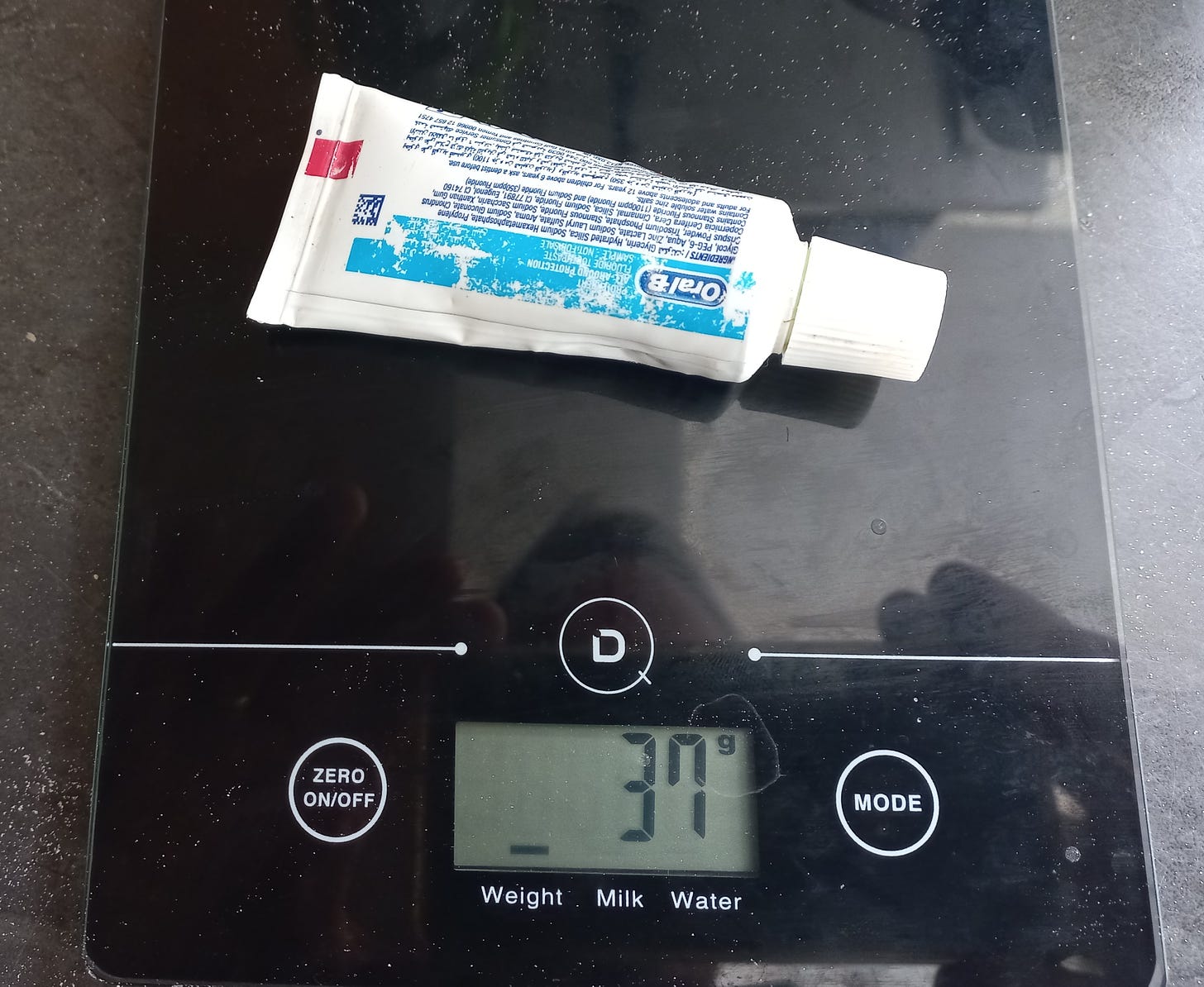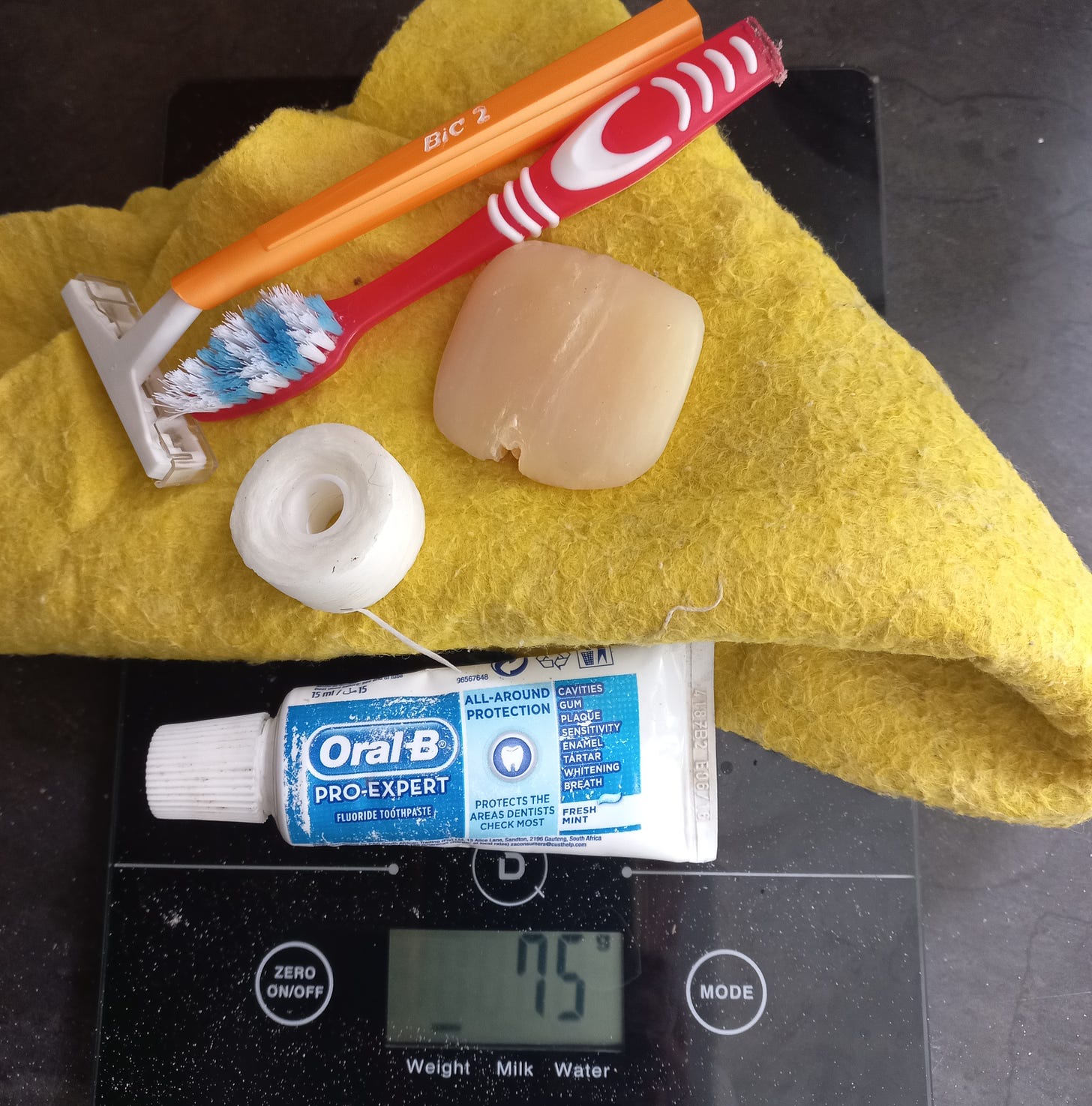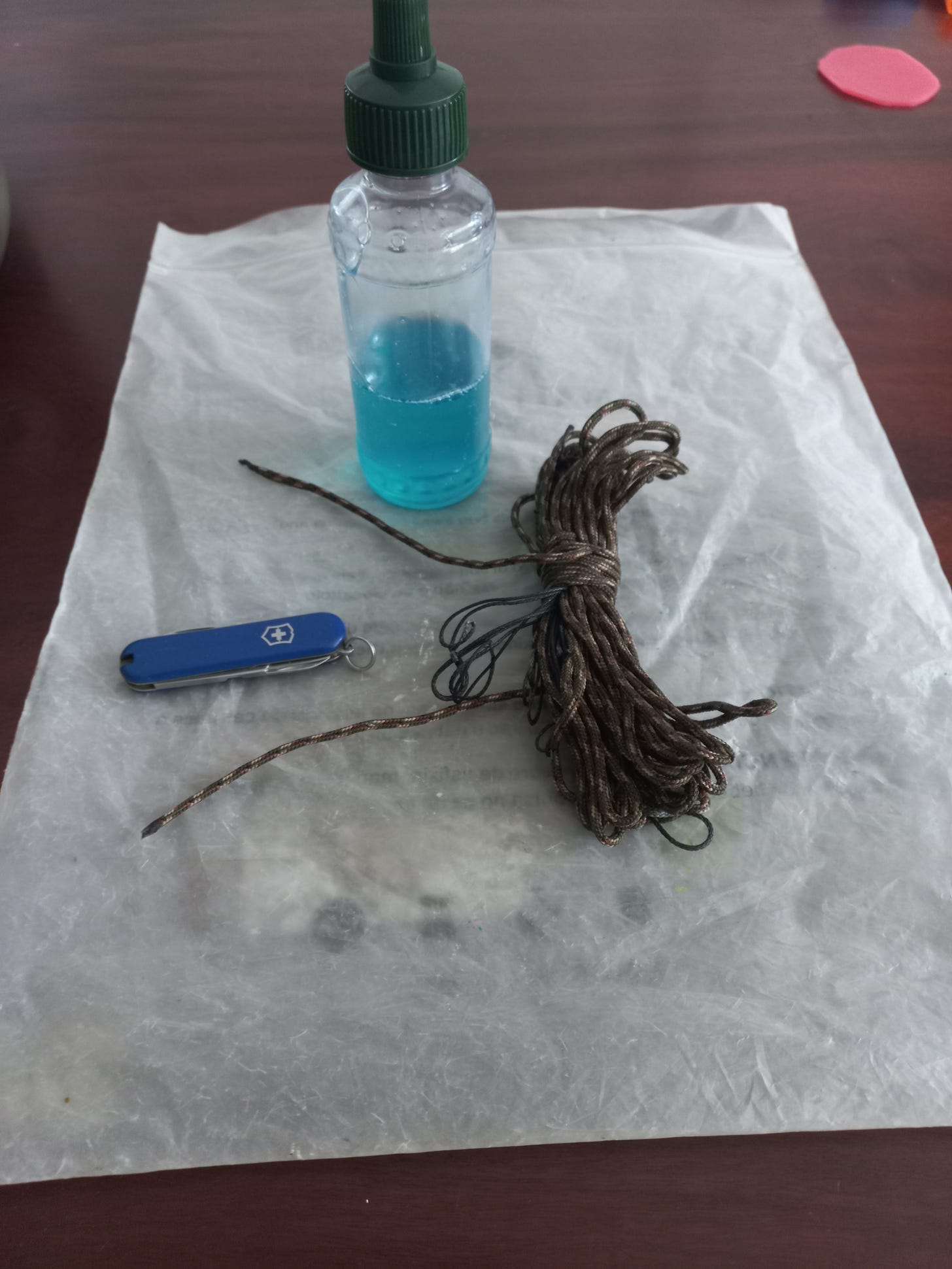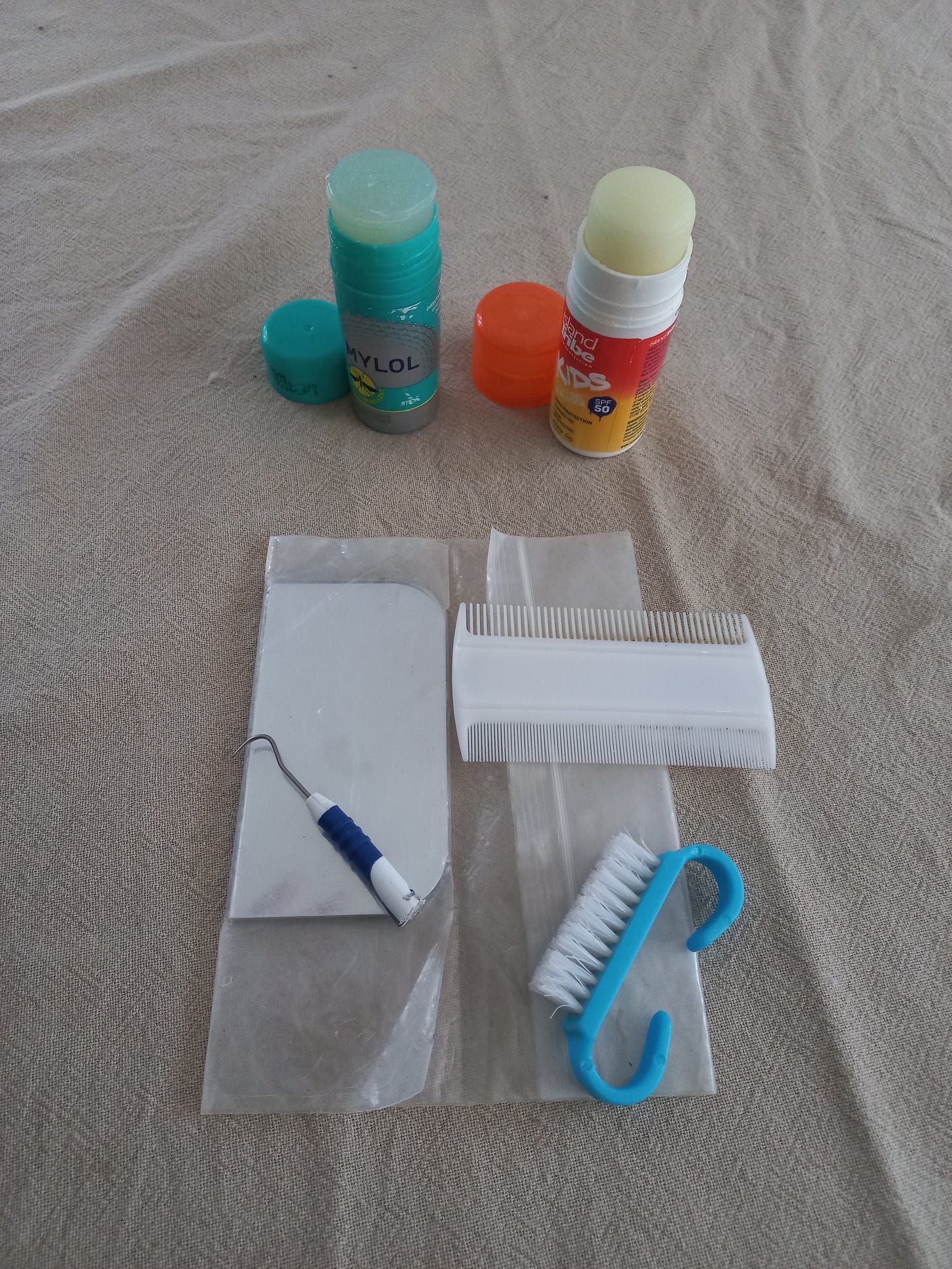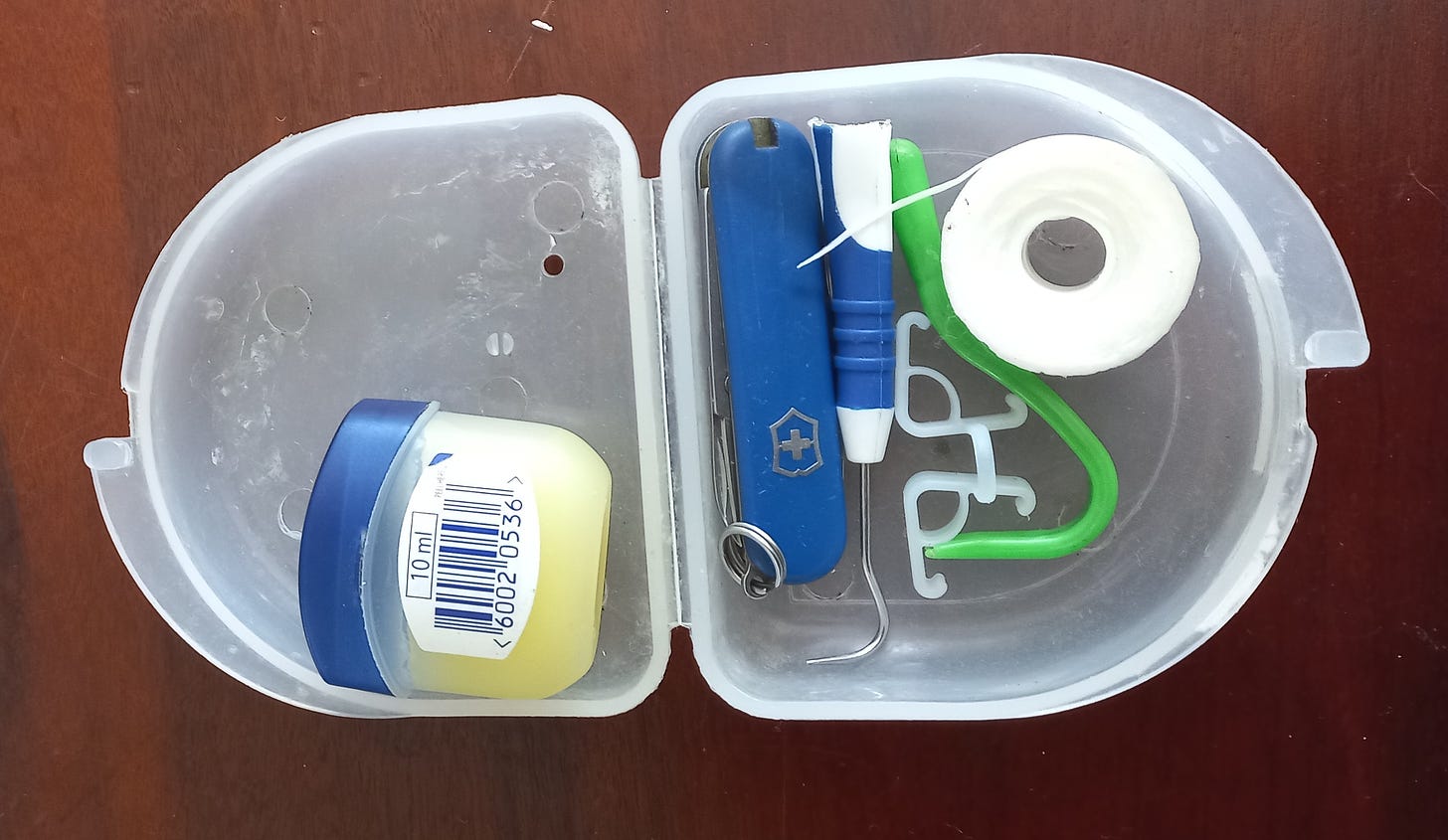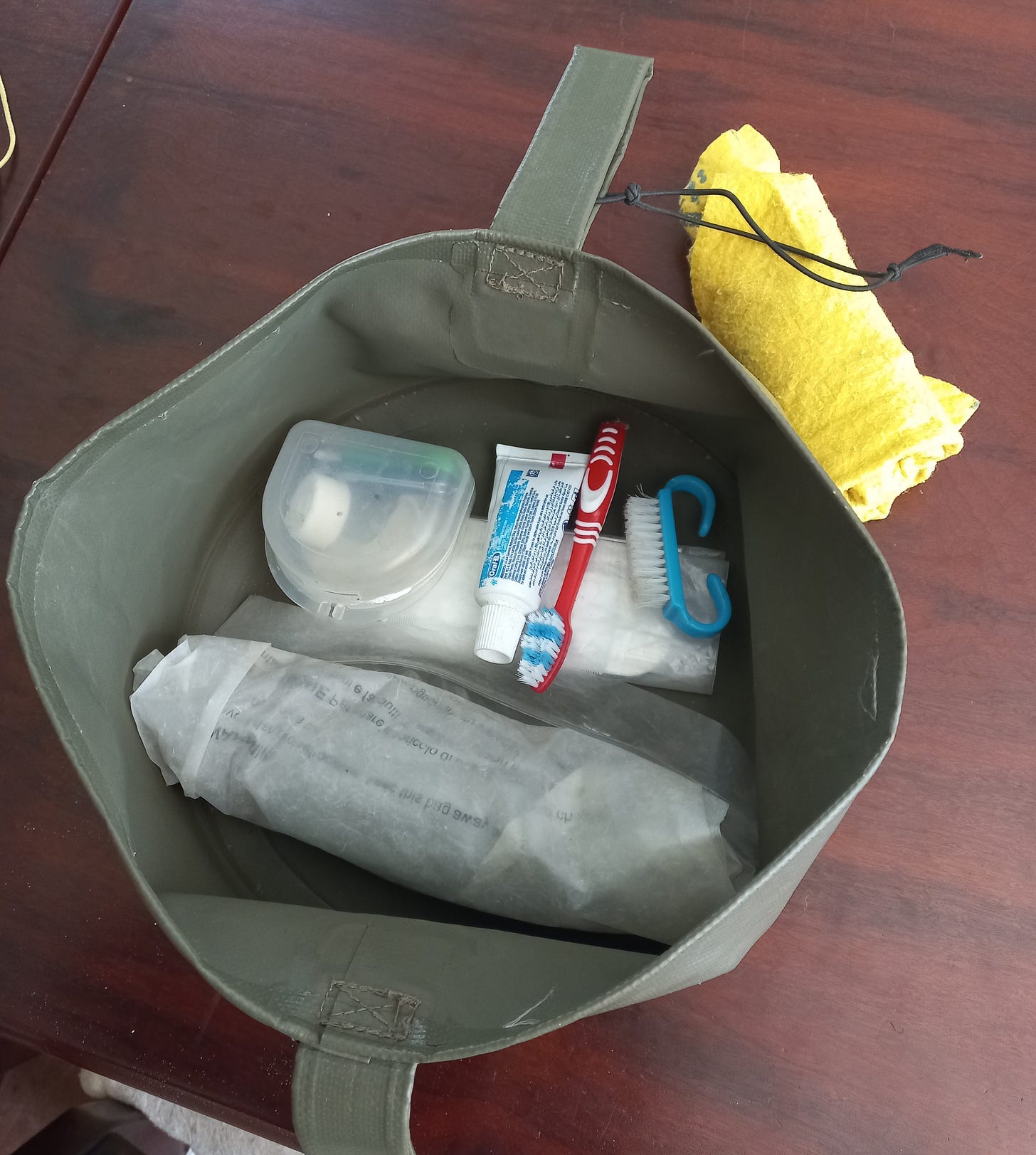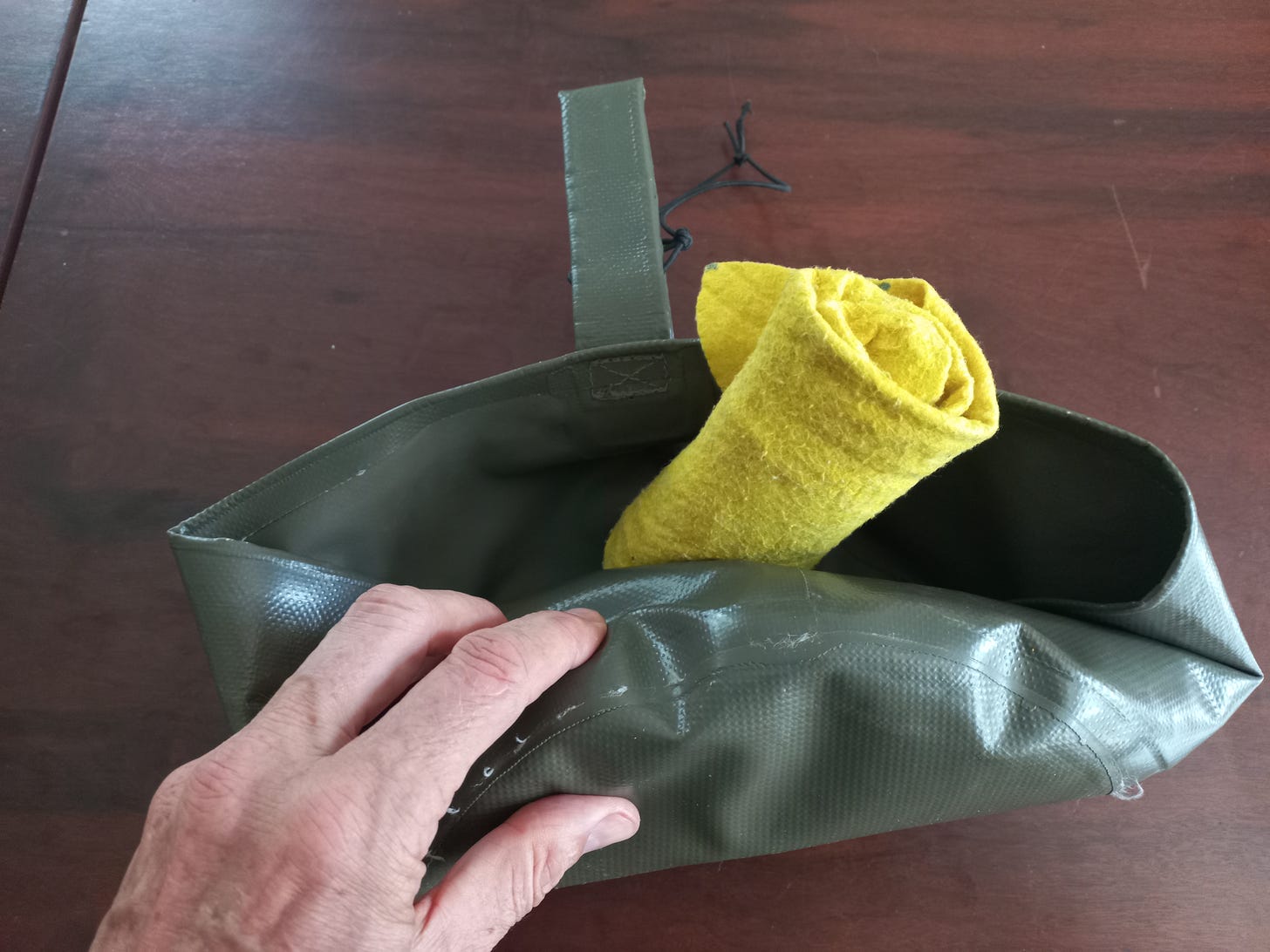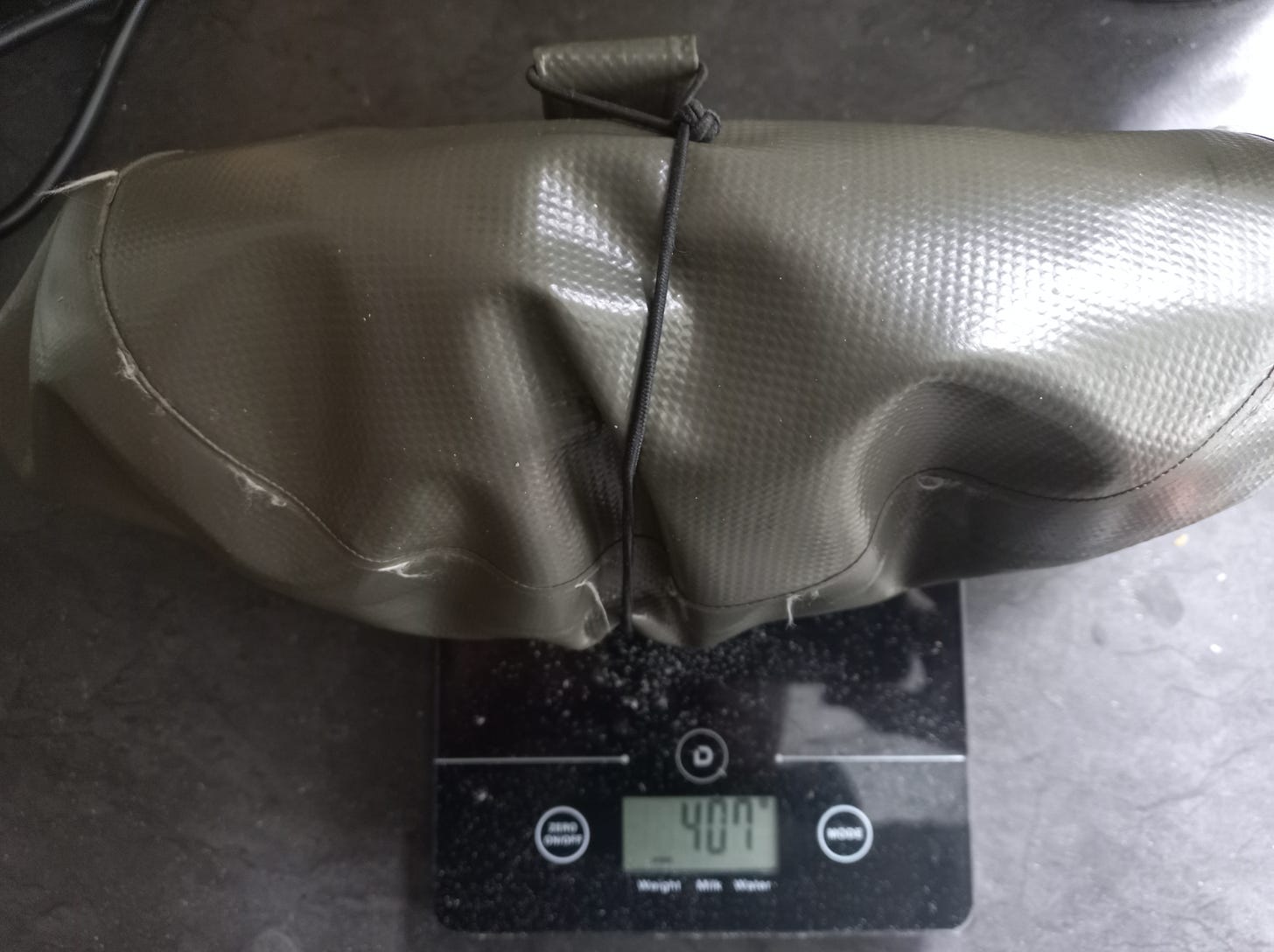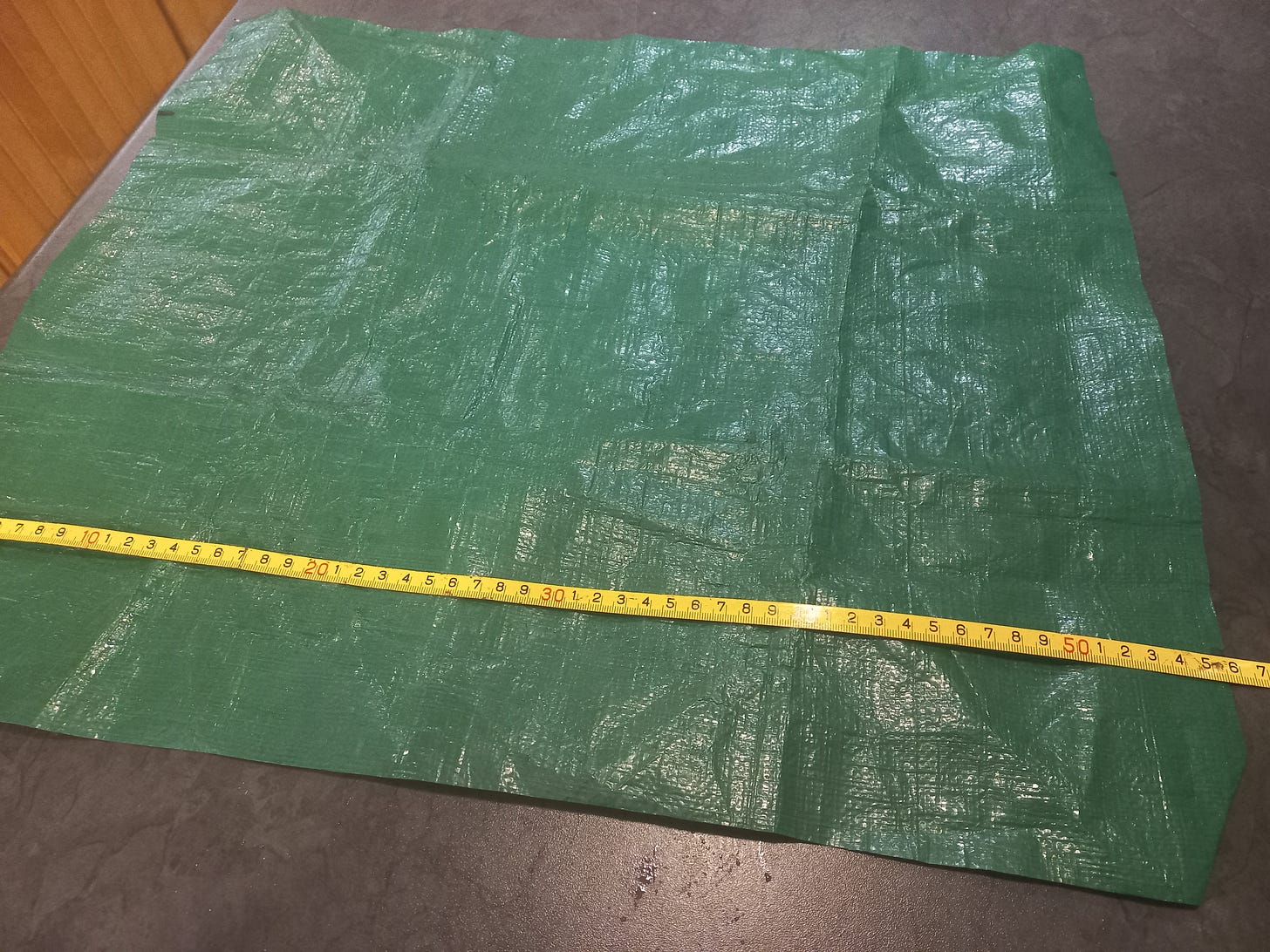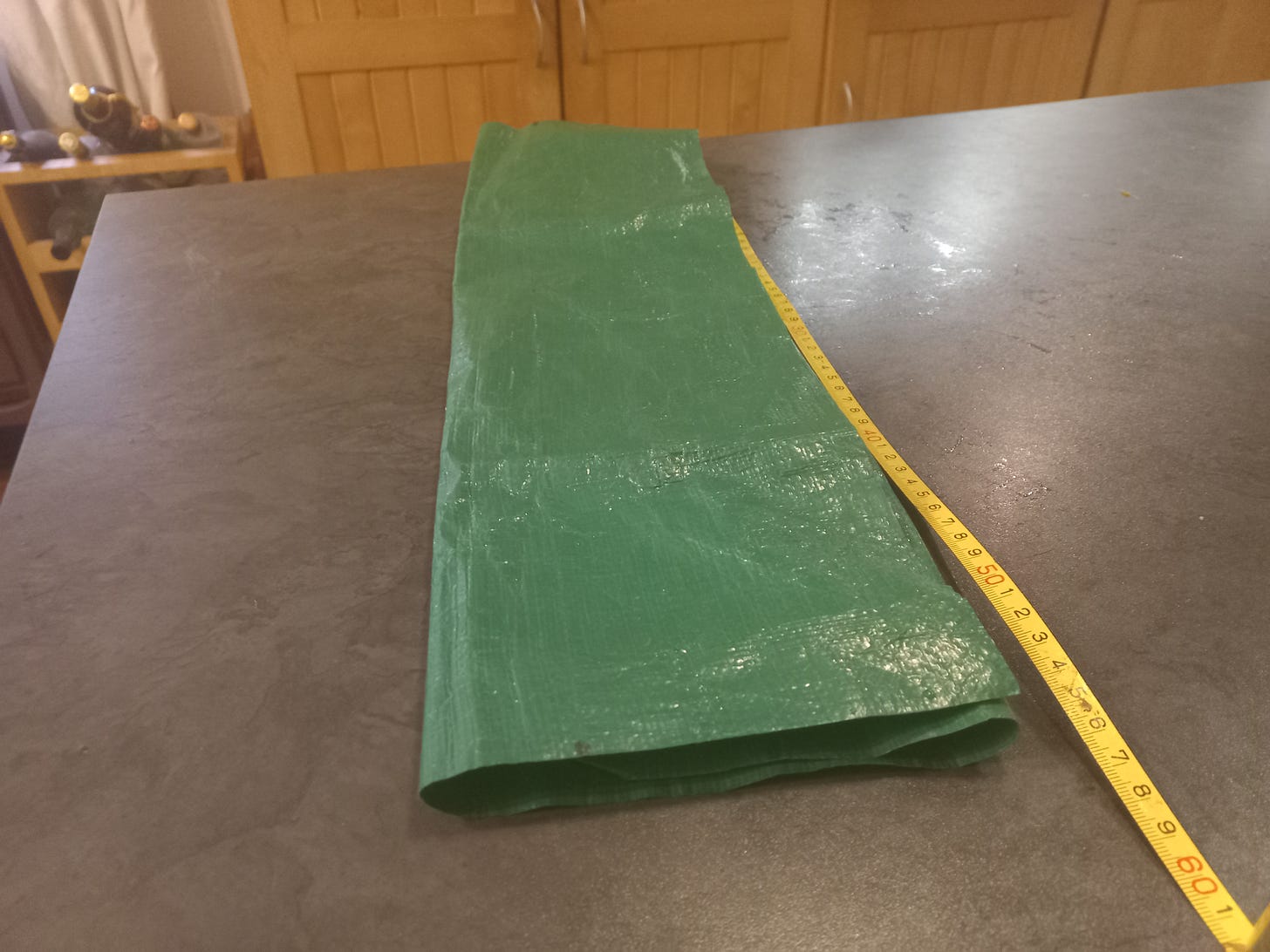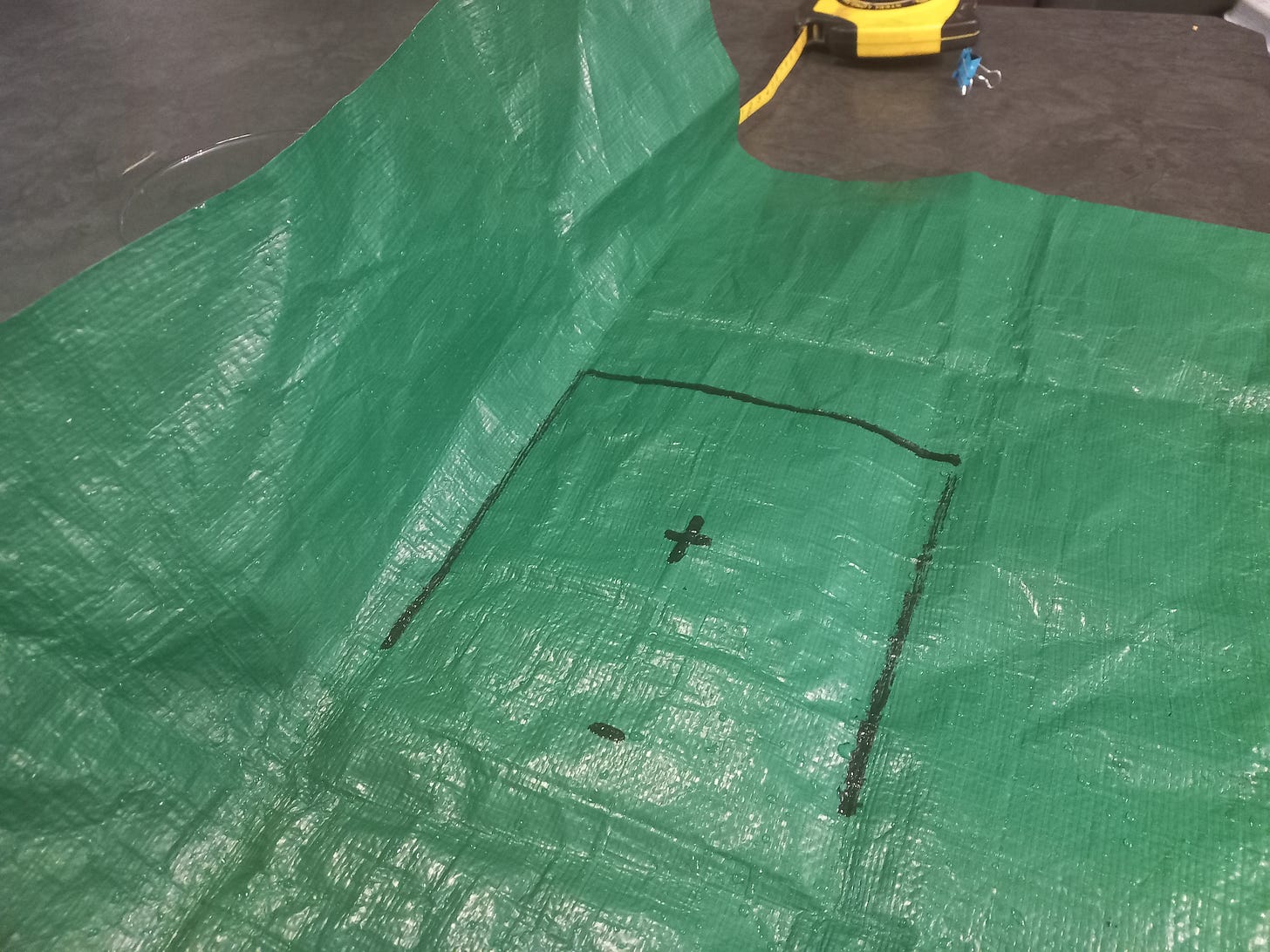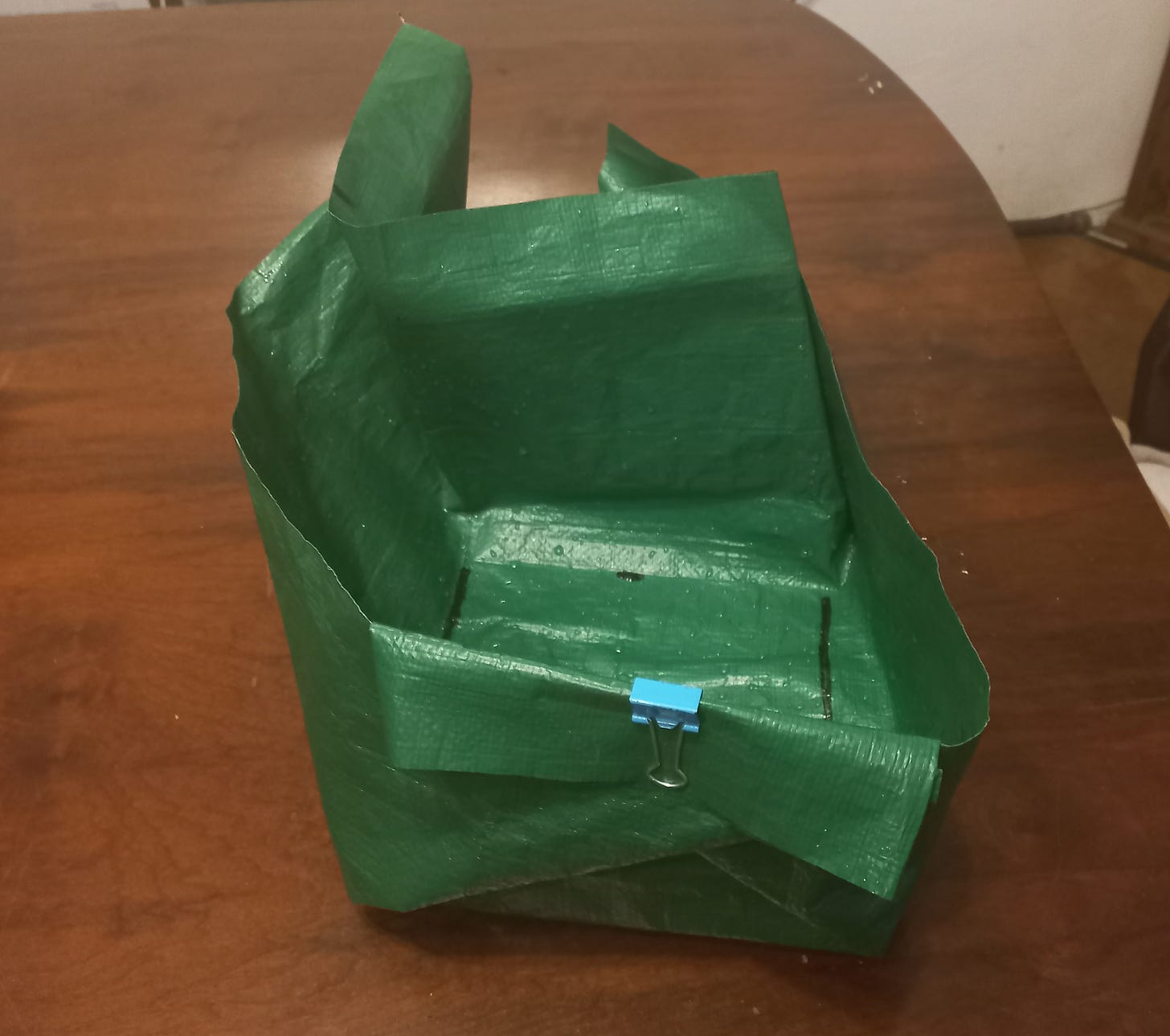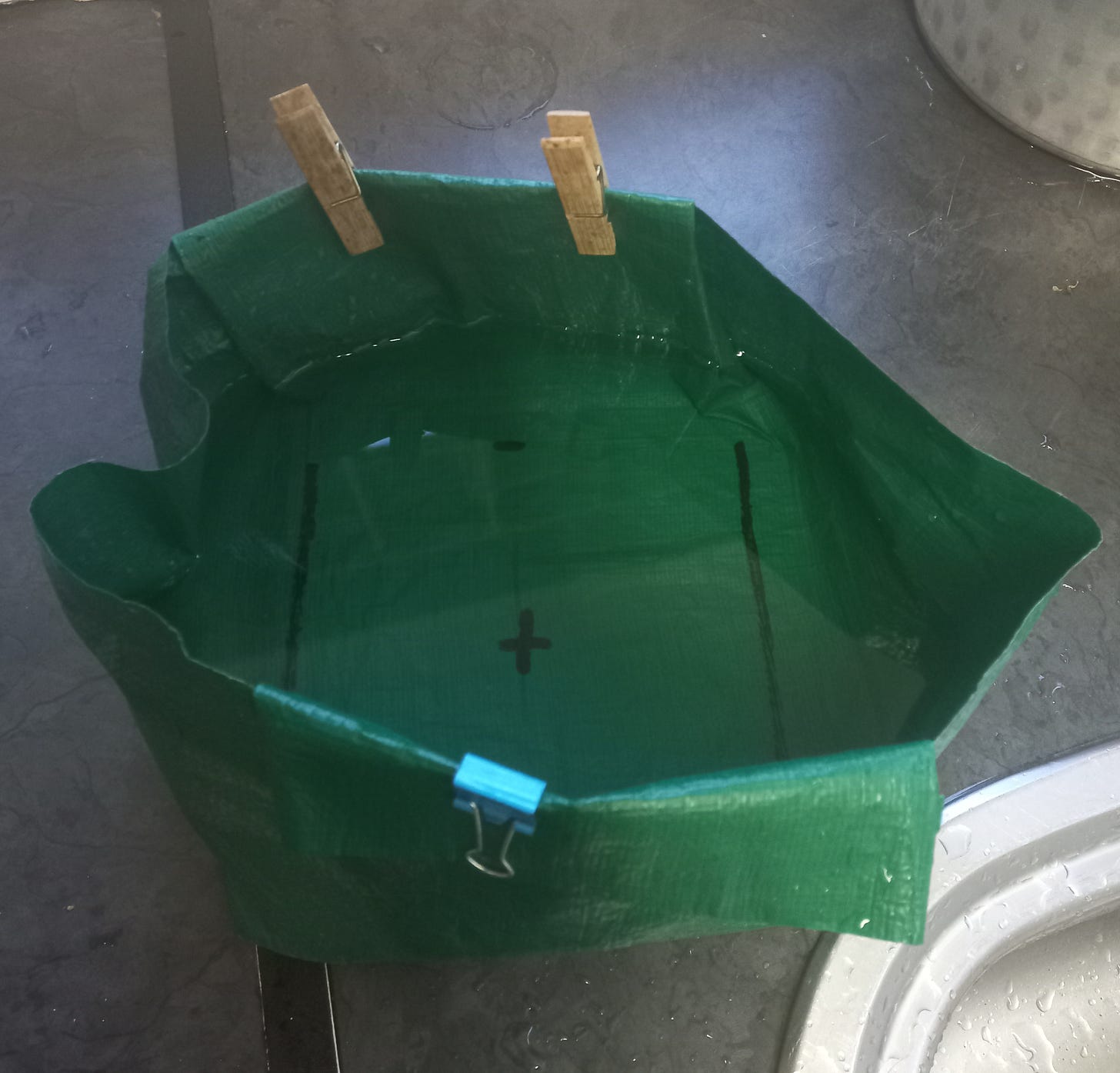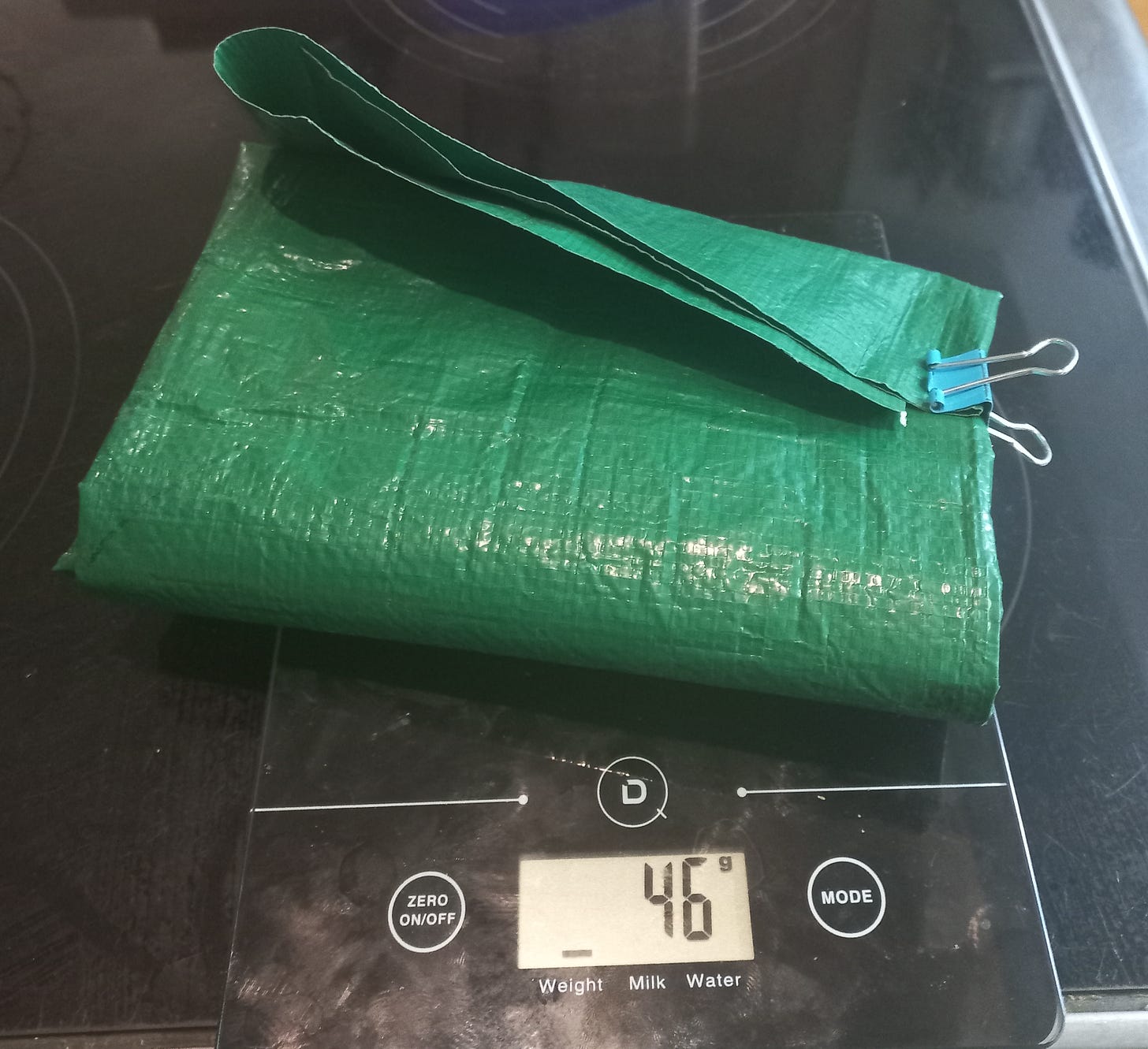Travel Hygiene (Be Prepared 3)
Stick THIS in Your Bugout Bag! - Two "Secret Weapons" _____ "The Skinflint's Guide to Washing"
1 Why ____ 2 What (kit) ____ 3 When ____ 4 How
You can listen instead here but this is where the photos and links are!
1 Why?
Why bother with washing if you are travelling - especially backpacking, or in an emergency? I think there are three groups of reasons which very often make washing worth doing.
(My immediate reaction to that is - “am I being a complete hypocrite?” – for I’ve surely done more than my share of wandering around “The Great Outdoors” being part of “The Great Unwashed”! There’s no shortage of occasions when I went without washing until I got back to base; or used whatever foliage came to hand to wipe my bottom; or dumped all the dirty kit from an expedition into the washing machine for it to sort out; and so on. But I am not preaching that you behave in any particular way: I am just exploring the pros and con’s of this area of behaviour, for your consideration).
When I was a young man, I worked in outdoor pursuits, taking individuals or groups sailing, or mountaineering. In one of the outfits I worked for were some ex-military characters, who explained to me that one of the first experiences squaddies had - (new recruits, “grunts”) - was to be taught to wash “in the field” using soap and just a mess-tin of water. A corporal would stand in front of the squad, strip naked, and demonstrate how to have a complete wash. (The British Army wisely assumed no pre-existing knowledge, and taught you everything you needed to know. I suppose that way there can be no excuses)! Modern forces worldwide put quite a bit of emphasis on hygiene: I once read that the First World War was the first war in history that wasn’t decided by which side got dysentery or typhus first! (War, not battle, notice).
They at least think washing is worth bothering with. And I agree, for three types of reason:
hygiene (avoiding disease);
morale (keeping as constructive an attitude of mind as possible); and
mixing with other people.
1a Mixing with other people
Have you ever smelt anyone who has been in the same clothes for two or three weeks - perhaps someone homeless, or mentally ill, or in warfare? It’s not like armpits but stronger: it’s a different smell.
When armpits smell it’s because bacteria start to break down the pheromones produced there. (Pheromones are chemical messages from one individual to another, which today are probably mainly redundant and atavistic) . The tiny amounts of breakdown products smell strongly, but are not necessarily indicative of being particularly dirty.
But if you keep the same clothes on for weeks, then the dead skin cells, which you shed constantly, build up, and since you keep them warm and damp, they rot. Picture the contents of your vaccuum cleaner, which is mainly dead skin cells. Imagine putting a handful of that inside your shirt, and keeping it there for a couple of weeks. Since they contain protein, one of the products of breaking down the dead cells will be ammonia, which will be a major contributor to the eye-watering smell of rotting flesh.
I know from watching the vlogs (video logs) of people who do those long-distance hiking pathways in the US that take months to complete, like the Appalachian Trail, that it is very common not to wash until the occasions - once a week or so - when you leave the route to go to the nearest town to resupply. On the trail, if everybody you are with smells about the same, you might feel that being a bit pungent yourself doesn’t matter. You are likely to mix with other people, though, on the way to re-supply points, if you hitch a ride, use a bus, or interact with people in shops or at your lodgings. If you smell too bad, maybe they will be less inclined to give lifts to hitchers in future.
But if one thinks more in terms of a “bug-out bag”, then surely it is not hard to imagine situations when you would want to be able to merge with wider society without looking or smelling out of place, as if you have just slept in a ditch for a couple of nights.
I mentioned in “Be Prepared 2” that I was recently (due to covid) without notice, unable to fly home for nearly six months, and had to manage with my lightweight rucksack contents! A lot of that time was spent wild camping, and it was certainly an advantage to be able to go into shops, or get on a bus, and pass for “normal” (or as near as I usually get to it) . The image was of a fresh clean-shaven hiker, rather than a tramp!
Even then, I had a foretaste of what is to come in the UK. “Wild camping” (formerly known as “camping”) had recently been made illegal in all parts of the UK except Dartmoor. (Fortunately Dartmoor was where I was for most of the time). A “responsible citizen” thought it odd to see someone with a backpack in about the same place twice, and quizzed me politely but firmly about what I was doing. You can’t travel on trains or the Underground for more than a few minutes without being adjured to say something to the police or “authorities” if you see something odd. “See it; say it; sorted”. It’s a nauseating experience for those not under the spell of “the authorities”, or those who know the true significance of Operation Gladio.1 Since then there has been a court case which means that it may now be illegal to camp on Dartmoor. My parents’ generation, who thought they fought WW2 in order to live in a free country are currently turning in their grave.
Anyway, it certainly helped to look respectable.
1b Morale
Now this is a factor that is so easy to underestimate. One of the videos I recommended in “Be Prepared 1”, was by Brooke Whipple, who was one of the contestants in the US TV series “Alone” where people compete to last as long as they can in the wild, with only 10 items of their choosing. She lasted a long time, but eventually lost so much weight due to the lack of food available where she was dropped, that the programme makers pulled her out. One of her 10 items was a bar of soap. Bear in mind that she was literally starving, and that instead of that soap one of her items could have been a collection of emergency rations. She - and her husband Dave, who was also there with her - preferred to have a bar of soap with them, when they were slowly starving, than a chunk of emergency rations. That was their opinion before, during and after the experience.
Really?!
Well, there is the obvious consideration of feeling more comfortable. “Monkey-butt” is an American term that (mercifully) was unknown to me before I came across those long-distance hiker vlogs. Fortunately it probably requires little elaboration. Being sore all day is a big tax on your mental resources.
But washing will do much more for you than make you physically more comfortable. If you are in a situation where you have had to grab a prepared bag, and leave home with no notice, it’s probably going to be quite stressful. Without dwelling on what circumstances it would take to do that, I suggest that it’s likely to have been quite traumatic: fire, floods, civil unrest, war, disease, New World Order … whatever it was is going to feel quite threatening.
When the World feels a hostile place, it helps to feel that there is someone looking after you2 – even if it is only you! So take the trouble to look after yourself. In fact it might be wise to have the attitude that the more upsetting the situation is, the more care you should take in looking after yourself.
Many animals do a similar thing: when the situation feels too stressful or confusing, bees, or cats e.g. will stop tackling it and start cleaning themselves. It’s a calm, routine thing to do, which makes the World feel more normal and under control. When there are significant factors that you cannot control (and there always are) it’s helpful to focus on those things that are under your control. Washing won’t just make you feel more comfortable, it will make you feel more normal; more comfortable mentally.
That is why, in preparation for such an event, however unlikely one thinks it might be, it is useful to make that travel washing process as routine as possible. By which I mean that you can make your “travel” washing technique more like everyday washing, and make your everyday washing technique more like your “travel” washing, so that in a stressful situation, it requires little thought, and feels normal.
Keeping comfortable in adverse conditions is largely a matter of taking a little trouble to avoid problems. Simple examples include putting on a jumper as soon as you get less than comfortably warm; and taking it off to avoid having to sweat to keep cool. The more tired you are, the more likely you are not to take the necessary trouble. I dare say most of us have been guilty of getting tired and falling into bed without changing or washing on some occasion - and that’s in easy circumstances at home, let alone when you’re tired and stressed, and after an unaccustomed walk, and having to set up a camp.
When I was a student, I read everything by Primo Levi, an Italian Jew who survived his years in Auschwitz. I was intrigued to learn what it was about him that enabled him to survive. One of several factors that I came up with was his incredible self-discipline, of not expecting life to be easy, but rising to the occasion.
If you are going to thrive, then the effort you put in needs to be in proportion to how difficult life is.
Most people, when things get tough, give themselves excuses not to bother. It helped that as a teenager he and a friend had gone rough camping on their weekend climbing trips. The definitive moment came at the end of the war, when he was in bed in the infirmary, suffering from malnutrition and multiple diseases, including typhus (if memory serves) and semi-starved. The Germans had marched out with survivors, and he had been left as moribund. He survived the freezing days before the Russians arrived, because he got out of his sick-bed, and went and searched, in the snow, in his “pyjamas”, for a stove; he found one, brought it back to his hut, got it working, and made a fire. Try and imagine the will-power and self-discipline required, when he was feeling terrible, to get out of the relatively warm bed, when he had every possible excuse to feel justified in staying there. It would have been the very last thing he felt like doing.
My advice is to try and avoid getting tired, and to get things done before it gets late in the day. Make it easy for yourself by not needing too much self-discipline. It’s so easy to get into a vicious spiral of tiredness. You didn’t take enough trouble with fixing a fly-sheet, for example, so your night’s sleep is interrupted, and you get wet and cold, short of sleep, catch a “cold”, and as a result it’s even harder to be bothered to take further steps that need a bit of effort.
Remember - “surviving” is not good enough: you are planning to thrive!
1c Hygiene – avoiding disease
Avoiding getting an upset stomach or an infected graze to add to your burden are possibly too obvious to require mention. Having sore skin, toothache or sore gums will also not help your equanimity.
In thinking about what to say here, I looked at the vlogs of several hikers’ and ex-military survival experts. A recurring theme, especially for women, was that there were various limitations because they couldn’t wash. (E.g. using a “mooncup”, like this lady did, but which this lady says she might have prefered if she had been able to wash her hands). Simply having soap and water, a basin and towel makes a huge difference: it’s something you take for granted till it’s not there.
Now I’m hardly qualified to give advice on feminine hygiene: not only am I not a woman, I have to confess … (and I know this sounds so “last century”) … I have never even been a woman. So I have, in this footnote3, quoted what seems excellent advice for women, from Trinity Ludwig, who completed an 11-month trek the length of South America.
There are other aspects of hygiene that are worth considering, that don’t necessarily involve washing at all.
Sleep hygiene
If you are planning on being able to live on your own resources for a day or two or more, carrying everything you need and sleeping well, then you need to practice. “Practice makes perfect” may not be literally true – but it makes a surprisingly big difference! There’s a good reason why the armed forces go in for training! So find people who like backpacking, learn what you can from them, and get out and try it. The chances are you won’t get much sleep at your first experience of being in an unusual situation. Being short of sleep is the last thing you need when the chips are down and you need to be making sound decisions; so you need to get enough experience until it feels normal and you sleep well. Sleep is vital for your immune system to function well, as well as your mind. You don’t want to feel drained of energy.
Airing bedding
Some everyday things that you do may not occur to you as steps you take for the sake of hygiene. For example ventilating your bedroom, and leaving your bed airing all day rather than putting it in a plastic bag; perhaps turning down the bedclothes for an hour after getting up, to help that airing (i.e. drying) process.
One of the ways in which we restrict the growth of bacteria and fungi around us and on our skin is to be clean and dry. Think of soldiers in WW1 in the muddy trenches: “trench foot” (nowadays referred to as “immersion foot”) was a major problem. If you are in a tent, the humidity can easily go up to around 100%, when things will not dry. If you then get up in the morning and put your sleeping bag in a waterproof bag, and then into your rucksack, it will be damp. When you get into it that night, you will warm it up and the bacteria and fungi (moulds are fungi) will be in the ideal environment for multiplying. You have supplied them with all the things they usually lack: food (oil and dead cells from your skin), water, and warmth. (They can also break down natural materials like duck-down and cotton, and get energy from that). When you repeat that for two, three or more days, the growth of bacteria and fungi will be exponential. The moulds will produce spores by the million, which float around in the air, and are common allergens.
This happened to me once when I was doing it for a living, and something very similar may have happened to “Dixie” the protagonist in the extremely popular YouTube channel “Homemade Wanderlust”. I wouldn’t, of course, presume to know exactly what allergen was affecting her, which she discussed in her vlog, but mould spores from her down items seem a likely candidate for consideration, given that she and I were behaving as I described - putting a sleeping bag and/or down jacket into a waterproof bag for the day without airing it adequately.
Airing clothes
This is why it is important to change out of your day clothes and air them overnight. That exponential growth stops when they cool and dry. Even if you wear the same clothes for a second day, they will be much better if you didn’t wear them overnight. (A lightweight tarp. over your washing line makes this much easier in adverse conditions).
2 What (Kit)
I grew up in the rainy UK and spent a good deal of time walking, camping, sailing and climbing in the rainiest parts: the Brecon Beacons in Wales, where the SAS train; the Highlands of Scotland; the Lake District has a reason for having all that water! Dartmoor had an airfield in WW2, which had the distinction of having the most days in the year when take-off was impossible due to low cloud. Dealing with “dampness” was a major consideration in keeping myself comfortable and warm.
Perhaps that is why there is an item of kit that I think is more important than is commonly recognised.
First “secret weapon”
For me, up there with the second-tier “5 C’s” (see Being Prepared 2 Alternatives to the 10 Cs) is the first underestimated “secret weapon” - an absorbent cloth.
Having the ability to dry yourself when camping is not trivial.
They are usually yellow, a cloth made from felted (matted) plastic fibres. Its key property is that it will absorb a lot of water quickly (by capillary action) which you can then squeeze out, and then absorb more water. To take one or two with you costs very little in terms of money or weight.
When camping with children I often wished for an infinite supply of paper towels. This is too heavy, even for camping from a car. The absorbent cloth is the closest you can get, as if there is water to wash it in, it can be reused ad infinitum. As far as a travel towel is concerned it beats all the microfibre cloths and other things advertised as “travel towel” hands down, and I’ve been searching for forty years.
It’s not hard to see why the “yellow cloth” is better than the woven microfibre cloths and similar, advertised for the purpose. Wringing out removes water from it or any other cloth. Doing this twists the fibres together: you organise them to run parallel to each other in a spiral, removing the spaces between the fibres which is where the water sat. The “yellow cloth” is matted fibres running in random direction. That’s unlike most of the “travel towels” you see, which are made from fibres twisted into strands, then woven: those twisted strands mean they are already partly “wrung out”. So they will not absorb so much water.
Being made of plastic rather than cotton (like a bandana e.g.) it’s easy to remove the water as well. With cotton, the water is not only absorbed by capillary action, but is adsorbed – i.e. chemically bound to the cotton, so famously takes a long time to dry.
If you are in a genuine survival situation and water availability is just a seep over wet rock, or gathering dew, then these cloths are very efficient at absorbing, then squeezing water into your cup,
Not all absorbent yellow cloths are made the same. You need to look for the ones with the thinnest, finest fibres. They are usually sold in twos or threes: I’ve never found any of the ones sold in tens to be good. Start your search with ones sold in twos or threes in more upmarket shops.
In these pictures, the one on the left is a good one, on the right, mediocre. It’s the same cloths against a light and dark background.
Being a felt rather than woven not only means more spaces for absorbing water, but the wind blows through it better, and dries it quickly.
I have heard one other person, a survival expert, arguing for the importance of such a piece of kit, although his choice was one of the man-made “shammies”, a plastic alternative to chamois leather, commonly sold for washing cars. It is a close-run thing: I do keep one in a car kit and my heavier rucksack, where weight is not always at a premium; if I had long hair, I would probably want a shammy in addition; but my first choice is the cheap absorbent cloth. The shammy absorbs slightly more water, and wrings out at least as well, but it dries stiff, and deteriorates from damage when dry, and takes up more room and weight. The alternative is to store it wet (as the manufacturers recommend), when it is even heavier, and a home for micro-organisms to multiply in. It’s so smooth and soft that it’s not at all abrasive - less effective at the washing part, although it probably has the edge when it comes to absorbing. When hung out to dry, it takes about the same time as the matted cloth. Nevertheless it is a sound choice and has the advantage that you know that any brand will perform very well.
Having the ability to dry yourself when camping is not trivial.
The wind evaporating the water on you is the worst thing for making you cold (apart from actual immersion). The cloth is also effective at drying your kit, e.g. the condensation on the inside of your tent or tarpauline, before it drips on you; the bottom of your tent where you came in wet; your waterproofs; the basin you wash out of.
“You take a basin with you?”
For sure! The minimum I will have with me is the canteen cup which goes with my canteen and, as I keep them in my “handbag”4 (for want of a better term, US - “purse”) I have it with me all the time.
A handbag?! (To quote Oscar Wilde)
Contents of central compartment of “handbag” - a titanium canteen and cup
The “towel” (yellow cloth) plus a bowl (canteen cup) plus a piece of soap means you can wash yourself, all over, when water is available. In fact this is the traditional way people washed for centuries: a bowl of water, a bar of soap, and a cloth! There’s nothing clever or mysterious here: you just need to acquaint yourself with the technique ... oh - and take the trouble to actually do it - to wash! Just a couple of light pieces of kit make a big difference. If any one of those four is missing, it’s much harder. Most people neglect the bowl (and have inferior towels … and often have thin leaves of soap or bottles of detergent).
Soap, towel and razor. Since they took the trouble to print their trade-name on the “towel”, and it’s one of the good ones, let’s give them the advertising. Bic 2 razor is my choice. The pieces of soap are 15g (0.5 oz) - enough for a week or so; and 50g (1.8 oz) - two or three months. The string is to suspend it from a convenient line or twig, so that it is to hand, out of the dirt, and dries quickly, rather than absorbs water. A notch cut in the bottom of the soap and a constrictor knot at the top keep the string in place.
I keep saying “bar of soap” rather than “soap”, because people are liable to confuse detergents marketed as “soap” with the real thing. The real thing is lighter for the same number of washes; it doesn’t spill; and is far less damaging to the ecology than even “biodegradable” detergents. Do check the list of ingredients, though. I avoid anything marketed as killing bacteria, and therefore contains toxic substances, as I don’t wish to damage the natural bacterial flora of either my skin or the soil. Soap by itself is effective at eliminating bacteria.
The pH of skin should be 5.5, slightly acidic, which most bacteria don’t like: soap is slightly alkaline, so rinse soap off quickly and well. I also avoid soap with talc as one of the ingredients, since a percentage of that may be asbestos. Coal tar soap - known to be carcinogenic - is now no longer available, I believe. Normally the cheapest is the simplest and best.
The “yellow cloth” fits easily into the canteen cup meaning it is simple to sterilise it in boiling water, if it’s starting to get manky because you haven’t been able to wash and dry it.
Second “secret weapon”
But normally for travel, whether by plane or walking long distances with a lightweight backpack, I will have a larger basin with me. It is the second “secret weapon” that makes washing yourself and your clothes possible or easy “in the field”. It doubles as the case I keep my wash kit in. I have used them for decades; mine has been in use every day, and shows no wear. I prefer the PVC coated ones (like these used by Dutch and Belgian military) …
or these
However there are people I respect like this ex Royal Marine who like the Sea-to-Summit version, which is made of polyurethane coated nylon. The 5 litre model is a similar weight and size, but less hard-wearing than the PVC ones. (He uses the 10 l model, which is double the weight). Here’s a video showing it in action, from which you can see that the PVC one is more stable even without the metal reinforcement that the Sea-to-Summit has.5
Teeth
The other absolute essentials for maintaining yourself form your tooth-cleaning kit. Brush your teeth morning and night, and floss every night. In a sticky situation having toothache will not help. In the UK, most people over the age of 18 have no teeth of their own! That’s due to gum disease, due to not flossing, not decay due to not brushing.
Save weight and space
Cut down the toothbrush handle: they are usually longer than necessary. You don’t need the plastic container that the floss comes in: use a knife to cut the floss. Take only enough toothpaste for the time away. I decant toothpaste into an appropriate-sized tube (non-fluoridated - not the original stuff in this tube). This one will last about three weeks. If it runs out, in the absense of shops you can fall back on soap. Apart from flavouring, toothpaste is soap plus abrasive grit. Notice that the miniature tube of toothpaste makes up half the weight of the essential items: so consider tooth powder.
For a lightweight kit, for a month at a bit of a stretch, add a second razor, making 80g (2.8 oz), assuming you already have a large mug or canteen cup, a pot or mess tin. The yellow cloth could also be cut down in size. 32 cm x 25 cm is quite adequate. You could probably do with less than the 100 m (100 yards) of floss shown here too, but why bother when it’s so light and such useful cordage? You can also snap off the orange handle extension of the razor for weight and (especially) space savings.
Laundry
Your clothes also need washing. The folding basin not only makes washing yourself much easier and more pleasant, but means you can keep on top of your laundry without outside assistance. My laundry kit consists of
a small bottle of washing up liquid and
a washing line with “sailors clothes pegs” - loops of fine string.6
The photo shows enough for about a month. Laundry can be helped with a small nailbrush (shirt collars). A hard toothbrush (a “smoker’s toothbrush” is best) with the handle cut right off would be suitable for a really lightweight setup.
I prefer bottles with screw-on tops rather than snap-on tops, to avoid spills. Look for ones which will dispense drops, but have a larger top section that you can remove, so you can refill it easily. Contact lens solution bottles can be good. In this photo is a bottle that contained some sort of hair oil (I think), where the lid unscrews in two sections. The top section loosens to dispense drops, and the whole top unscrews from the base for refilling.
The line helps with a problem that you don’t realise that you have until you do some lightweight backpacking: where to put things down (without losing them and keeping them clean)! You don’t have to be drying stuff to find the line useful. My line is much thinner than paracord (1 internal strand - saving weight and volume); it is not dyneema which is slippery: the kernmantle construction gives grip so things don’t slide along. My loops are from 1 mm dyneema.
Other Optional Bits and Pieces
Also shown for scale is the classic miniature Swiss Army Knife (SD) which is 6 cm long (2.3”). It’s essentially a manicure kit. For a long trip I would normally take this, if my main knife did not have scissors. Short nails are easier to keep clean.
For facilitating washing in airports and similar places, which often have basins without plugs, I’ve cut a roughly circular piece of pink, soft, flexible plastic, which will sit on top of the plug hole, and work adequately as a plug.
The translucent plastic bag means I can separate off some items, or tip out the entire contents of the PVC basin onto something plain and clean, in order to use the basin.
Other items you might consider are shown here.
Insect repellent, sunblock, toothpick (cut down); comb - worth checking your head thoroughly for ticks - combined with fine-toothed comb - in the the unlikely event of needing to remove nits - lice eggs - (when it will be essential). But bear in mind that schoolchildren often suffer epidemics of nits (lice), and they were rampant by the end of World War I and II. The emaciated bodies seen in photos taken at Belsen e.g. at the end of WW2 were the result of typhus - spread by lice.
A plastic mirror (cut down) - facilitates checking your body for ticks, as well as checking your face for food or snot!
This little plastic case (originally from a mouth-guard) reduces the number of loose items knocking around, and mainly contains things that one might use in a hammock, at ease, away from mosquitoes, after washing which would take place outside, but a polythene bag is much lighter.
The green item is a little plastic moulding designed for removing ticks. Twisting avoids mouthparts or vomit being left behind in the skin. The white plastic device next to that is for holding your nostrils open. There are two times when that can be useful. 1 If you are walking fast, but trying to avoid panting, which loses a lot of water. 2 If your nasal mucosa swells at night due to an allergen. (I’m glad to say that both these items went unused in my recent six-month “bug-out”).
How to Pack
The complete kit being put away. This is what I fell back on whilst I was away from home all that time, to keep me and my clothes clean successfully.
As wash-bags go, it is easier to see the contents in this than most.
The towel (yellow cloth) can be very effectively wrung out: fold in half a few times rather than screw it up, so that you aren’t tearing some places while others are not being squeezed. The part between your hands will be well wrung out; then do the parts you were holding by folding the corners into the middle. It may still be perceptably damp; the bar of soap, too. The soap is rolled in the yellow cloth, which keeps it away from all the dry items. The razor is rolled in there too, tucked around the soap; this keeps the sharp edge away from everything. You don’t want knicks in the waterproof basin. (Surprisingly, it doesn’t damage the towel). The damp roll is then kept away from dry things inside the kit, and outside the kit by putting it in between the rolls of the basin as it is rolled up:
… that’s if it can’t be drying under a net on the outside of your pack, if it’s raining for example.
Rolled up, and held closed with a rubber band or elasticated cord.
A very comprehensive kit, for washing and laundry weighing 400 g or 14 oz.
Almost everybody recommends having “Wet-wipes” in your kit, and I’m sure I would get some if I were going to be in a desert e.g.; (also those paper towels which are squashed into a little dry block). Wet-wipes seem pretty undesirable on the ecology front, however. And if they have soap on, you would be better rinsing that soap off. If you can do that, you don’t need wet-wipes.
Two Basin Alternatives
Instead of one of those PVC basins or the Sea-to-Summit sink, you can use a robust dry bag (sometimes called a “canoe bag”), and fold the top half down; but they are not so robust or stable as the real thing. A puncture from a thorn … But for a put-ready-and-forget bugout bag, a dry bag would be good for a while.
Another item that might do a dual function is a simple piece of cheap PVC cloth (that you might get from garden stores or DIY shops). Cut a piece 34 cm x 56 cm. (Easy to remember - 34,56 - just over a third of a metre by just over a half metre.
You could use it for a convenient place to put things down so you don’t lose small items; or a cover to keep firewood dry; or if you have a sleeping bag that’s inside a delicate bivvy bag that you’re carrying on the outside of your haversack - wrap it round to protect that waterproof bivvy bag from thorns; or something to kneel on to stop your clothes getting muddy; or …
… or put it in a lightweight bugout bag as an improvised basin, if you fold it up, and hold it together with folding bulldog clips, or split green twigs at a pinch.
Fold into thirds the long way.
draw lines on those 2 folds, then make it a square, centred in the sheet.
Fold it using the square as a base:
Lo and behold - a slightly delicate but functional basin, big enough to wash your clothes in as well as yourself …
… for next to no cost in money or weight. (46g is 1.6 oz)
Those folding bulldog clips can also be useful for holding a tarp’s edges in place. (2 g each; for Americans, that’s 0.07 oz, or 30 grains, or 0.0003 stone or whatever you use).
It’s more of a faff to use rather than a circular one made for the job! But a cheap, accessible, versatile multi-use item.
3 When
I think the best time is the evening for a main wash, with just a splash on the face and an arm-pit wash for the morning.
The first reason is that you get it done and completed, and are ready for whatever you need to be ready for next day.
Another is that your night clothes (including sleeping bag e.g.) will stay clean for longer, if you go to bed clean. After all, you are not going to be getting sweaty or muddy in your sleep. You will appreciate not needing to wash your night-clothes so often if you are hand washing them.
Another good reason is that it is a routine maintenance activity, that requires little thought: just the sort of thing that is suitable for winding down to go to sleep. In the morning when your brain is at full throttle, you can do anything that you need to get on with, without wasting precious brain time doing simple chores.
Then there’s washing your clothes. If you do that in the evening, then they can be dry by the morning.
Finally, you give maximum time for the parts of you that don’t get much air – your feet and groin - to spend a decent stretch being clean and dry.
Ready to start supper on Dartmoor. Clothes and self are washed, using the PVC basin on that boulder and hot water. You can see “sailors’ clothes pegs” in use - a loop of string with a larks head (girth hitch) at each end. Nobody came into my spacious bathroom.
I’m not always very good about going to bed at a decent time. I find that getting the routine maintenance out of the way early, well before you intend going to sleep - the washing, eating, cleaning teeth and changing out of day-clothes - makes going to bed easier, and therefore more likely to happen, when you’re tired. This is one of the lessons I’ve learned - to apply to everyday life - from backpacking, when such the necessity for such a discipline is more obvious.
Beforehand
So that’s “when” in the sense of the time of day when actually travelling, but the other time worth emphasising is beforehand. You really need to practice. This does not necessarily mean getting out and camping. Most of this can and should be done at home.
Try out the following …
Can you cut and clean your fingernails and toenails with what you are actually taking?
Wash yourself all over at a basin instead of a shower, using a yellow cloth to dry yourself. You may even find you prefer it. It is conceivable that water could become scarce, or prohibitively expensive, and you find it more economical. It’s a basic skill that it does no harm to possess, and to know that you have it.
Every now and then, for a whole week. actually wash by hand your shirt, and underpants in whatever basin you are taking, and get them dry by the morning. Every other day should suffice if you’re not meeting royalty and it wasn’t a very sweaty day. You may not feel particularly like doing it, but it needs doing, and only takes about 10 minutes, including hanging them up to dry. You may think “how can that be enough time if the fastest programme on the washing machine takes 20 minutes?” Well with your hands, you can be much more effective at forcing water through the material than just jiggling the water about as a washing machine does. The main purpose is to move dead skin cells into the water. Add a very few drops of detergent. If squeezing water through in every conceivable direction with both hands for a couple of minutes isn’t sufficient for some part e.g. your shirt collar, then take a bar of soap, rub it on the spot, and apply a nailbrush for a few seconds. On one of the days you’re not washing your underwear you can wash your trousers; on another, your night-clothes. Find out if only a couple of drops of detergent are enough: how much oil do you think there is in your clothes?
Suppose it were raining all day and your hair is soaked. Can you get your hair dry so that you don’t get your bedclothes damp? Wash your hair in your basin then dry it with your yellow cloth. It’s easy. You just need to persist in blotting your hair, and wringing the cloth out well. It will take 3 - 10 minutes depending on how much hair you have.. (Blot, squeeze; blot, squeeze; blot, wring; blot, wring). If this is too challenging with longer hair, try with a plastic “chamois” (for washing cars) instead.
Air Travel Tips
If you have two long flights (perhap 6 hours or longer) with a stopover in between, then have a wash between flights. Not only will you feel better, but your neighbours on the second flight will appreciate it. If that stopover is in Dubai, take advantage of the free showers. If it is in London, don’t take out a second mortgage to get a shower there, just go to the toilets, use the basins provided to wash your head, then take your basin of water to a cubicle and wash the rest of you.
4 How
You will be relieved to hear that I shall not be giving a blow-by-blow account of how to wash yourself. That would be up there with Picasso’s strangely unsuccessful autobiography, “My Years Watching Paint Dry”.
In fact you are allowed to skip the whole section and work stuff out for yourself if you can just answer this simple question. Why did mediaeval washerwomen prefer to use rainwater for washing clothes, but river-water for rinsing?
What to wear?
The corporal’s technique of starting naked has the virtue of simplicity, perhaps speed, but little else to recommend it. In a lot of places it’s going to be unnecessarily cold, and some people may feel a little vulnerable displaying their all to the passing throng. And especially if in the military, circumstances might make it necessary to be functioning at short notice, and therefore to be close to fully dressed.
You could prepare for an all-over wash by changing in your tent into just your waterproofs. It helps to have a jacket thats long enough to cover the fundamentals! I’ve washed like this in the corner of a full public campsite with water heated on a stove, with my back to the rest of the campsite. From behind, your waterproofs mean that you look like someone preparing a meal; and if they have only just woken up, you can guarantee little to no attention.
It may be expedient to wear normal clothes but expose just a little at a time.
You can start with your head, without taking anything off (but remembering to take off your hat before washing your hair)!
Undo clothing in front of your chest to wash your armpits; if you need to respond immediately, you just need to do up some fastenings in front, and go.
Groin. If you need more privacy, get behind a tree, or a tarp, or put a poncho on, or have a longish waterproof jacket on, before lowering your trousers somewhat, and washing the part of your body that almost always gets covered, and really could do with a bit of air, to dry well.
Feet. You may take the view that your feet are more important than having fragrant armpits if you are walking a long way without the need to impress someone. Take off one boot and sock at a time, and you are just a sock and boot away from ready to go.
Managing with little water
As with most things, it helps to understand what you are doing, so that you are not having to remember some apparently arbitrary instructions.
Why use soap at all? Because it is an almost natural, weak detergent. A detergent is a substance that allows oils to mix with water, since one end of a detergent molecule dissolves in water, and the other in oil. This means you can remove the oil from your skin and hair, which causes things to stick. Soap is also slippery, and so allows particles to slide off easily. It also mucks up the outside of bacteria and viruses.
I say “almost” natural because the chemical process to make soap is so simple that it has been around for about 8 thousand years. You just add some wood ash to a fatty stew.
But from now on I shall refer to soap as “soap”, and if I say “detergent” I’m referring to much stronger substances made from petrochemicals, like the ubiquitous sodium laureth sulphate, that you find in just about every shampoo, “body wash”, “hand wash” and unguent unknown to man. Quite why people want to smear their skin with strong detergents I don’t know, except that they haven’t thought about it, and a bottle may look neater on a basin than a bar of soap. (Both pretty inadequate reasons in my view).
I’m talking about washing yourself with soap, as opposed to detergent, as I think it’s a much better idea, especially for people having to carry everything. It is much lighter for the same number of washes and can’t spill. For washing clothes, on the other hand, detergent is easier.
The answer to the mediaeval washerwoman question is based on the fact that soap is really not very soluble in pure water. Rainwater has nothing but a bit of air dissolved in it, and to try and rinse soap off with it is a slow, frustrating process, needing a lot of water. People who have installed a “water softener” in their house to stop the slow deposition of limescale on the inside of their hotwater pipes have the same problem: you can’t rinse the blasted soap off.
But river-water (or tapwater) has landed on the ground and had some contact with rocks. Some common rocks allow tiny amounts to dissolve in rainwater, and these dissolved substances will react with soap, using it up, and forming the substance known as “scum”.
So river water (or typical tapwater) rinses soap off easily … until all the “dissolved rock” is used up, when it becomes just as slow a process as using rainwater.
Then why did they prefer rainwater to wash clothes with, not riverwater? You can work that now, if you didn’t know. … You are trying to make a soap solution to wash clothes in. You get that immediately in rainwater; but in riverwater you will waste expensive soap (as it was then) having to use up all the “dissolved rock” before you get any useful soapy water.
So, if you’re washing from a mug, pan or mess-tin, how little water can you get away with, to rinse off the soap and dirt? That depends on the amount of soap you used - the more soap, the more water you need to rinse it off. Therefore you should use the minimum amount of soap for getting the job done.
(Also, rocks vary from place to place. So you’ll find out how good your water is at rinsing. But that’s not under your control: how much soap you use is).
Even when just using soap and water, there’s a range of mixtures that you will use, and it helps if you understand what substance you are using. [This list is in order of increasing amounts of soap, decreasing proportion of water; but to understand what’s going on, it might be easiest to read in the numbered order].
(4) In basin - Fresh water - contains “rock solutes” but no soap.
(5) In basin - dilute rinsings. When you rinse the first soap off and catch it in the basin, the “rock solutes” are still in excess: with only a little soap in a lot of water, you can still use this mixture to rinse more soap off.
(6) In basin - saturated rinsings. Eventually enough soap will exhaust all the “rock solutes”, and it will no longer rinse soap effectively. (Adding more soap to this would give a soapy solution you could use to wash clothes).
(3) soap solution - Add the minimum drops of water to wash the area. Soap is in excess, not the “rock solutes” which are all used up. (The more water you add, the less soap there will be, as it is removed by the solutes in the water: bear that in mind when washing your hair).
(2) soap “paste” - Add the minimum amount of water necessary in order to transfer some soap to armpit or groin e.g., perhaps under your clothes: then it won’t drip.
(1) solid soap - The dry bar you carry around
Technique
For a quick, effective, economical wash in a basin that’s big enough to get both hands in, wash your
head and hands ___ as if in a basin; [Not hard: that is what you are doing!]
armpits and groin _ as if washing a car; (& head & hands if using a smaller water container).
feet _____________ as if in a bath;
bottom ___________ as if in a shower;
remainder ________ as if dusting with a damp duster
I’ll explain “As if washing a car” in a moment.
You are only going to use the cloth to blot yourself dry. But before you start washing, wet the cloth completely, then squeeze it out with one hand.
“What?! Get the towel your going to dry yourself wet?!”
Yes! The damp cloth will blot up water faster than a dry one. The minuscule film of water you leave behind on your skin is so thin it will dry in about 30 seconds. I say “with one hand” meaning you don’t need to wring out the cloth, not until you have finished washing (except for drying you hair).
“As if washing a car” means like this. Wipe a wet hand on a bar of soap, to get some “soap paste”, and rub your hands together to share that soap out. Use your right hand to hold the yellow cloth, and your shirt open, then apply the soap paste with your left hand to your right armpit. Then add just a few drops of water with your left finger-tips and wash; grab the cloth from your right hand with your left hand and blot up the soapy water. Repeat with other armpit. Rinse the soap out of the cloth into the basin. That will get rid of ninety-something % of the soap on your skin, but repeat with just water until it feels as if all the soap is gone (which will probably be just once more). Use the same technique on your groin.
One advantage of only using a tiny bit of water is that if it’s not heated, then less water will cool you less than a cold shower. Another is that you will be prepared if water becomes in short supply or expensive.
Confessions:
This may well be nothing like how you wash a car – I don’t have much experience: mine I regard as a working vehicle, and it stays dirty)!
I may have lied about not going into detail about washing!
At this point readers of a delicate disposition should be warned that – before getting to some links to videos of other people’s suggestions and a few footnotes (including an important one for women) - we are going to think about faeces (“poop”) in this last section! Don’t panic though: there are no pictures.
Finally - Talking Crap
So we come to the vexed question of cleaning your bottom … (US “butt”) … when travelling.
TP is heavy, runs out and is useless if it gets wet.
A lot of people offering advice on this suggest wet-wipes. That is fine, easy, popular.
Drawbacks include
they will run out;
they are quite heavy (being wet);
getting very sore from the detergent on them is quite common; and
You have to dispose of them somehow.
Dave Pearson (of Fun in The Woods YouTube channel fame) addressing the question of how to handle the long-term, suggests having four flannels, using them, and washing them all when they are all dirty.
My second choice would be using appropriate foliage. That’s never presented me any problem. (Moss is a lot nicer and more effective than TP!)
None of the above would be my first choice.
Considering “Normal” for Westerners
Let us consider what we are happy to do already.
I guess that after defecating most of you wipe your bottom with flimsy paper, then wash your hands. And most don’t find that too traumatic.
Presumably most people have no trouble in using their clean hand to wash the dirty hand with soap and water.
Similarly, I guess that later a lot of you wash your bottom in the shower with your clean hands. You probably think nothing of that either.
Well I hope this doesn’t ruin a beautiful fantasy for you, but from a bacteriological point of view, that paper does essentially nothing to keep stuff off your hand. I remember reading many years ago about an experiment done investigating aspects of hygiene, where they got volunteers to use increasing numbers of sheets of toilet paper; then tested their hands for faecal coliforms (bacteria) or something, before the volunteers washed their hands. My memory is that they got up to 40 sheets before there was a significant reduction in bacteria from poop.
Now I may be going out on a limb, but I suspect most people do not wipe using 40 sheets at a time. And as we all know, this is why we need to wash our hands thoroughly after using the paper.
And how effective is that wiping with paper? How clean does your bottom get? Well I’m sure it reduces the traces of faeces left behind considerably; but you must concede that it will not be clean: from a bacteriological standpoint you have merely smeared the faeces over a larger area!
In the Western World most people are content with that, and happily go around in that state until they next have a shower. It’s one of those routine things that we do that way because that is the way we were shown when we were small, and we’ve never had cause to give it much thought.
Other Cultures
But if you go South from Britain, through France, an increasing proportion of people routinely use a bidet, to wash properly. I suppose as the climate gets warmer and bottoms sweatier, the need for better hygiene becomes more obvious. By the time you reach Arab countries, the conventional technique is not to use paper, but to wash with water and (normally) soap. Crusaders from Britain arriving in the Holy Land around a thousand years ago were amazed at how clean and civilized the Arabs were by contrast to them. (In doing a little research before writing this, I came across examples in a blog, of Americans who thought that the Arab convention of “using your left hand”, meant using your left hand instead of paper, rather than using it to wash yourself. You can rely on there being a few Americans giving amusement to Europeans by living down to the stereotypical view Europeans have of them as insular and ignorant – I’m sure just a tiny minority, such as you would find anywhere in the World).
Overcoming the Taboo
Let’s try a different perspective. Suppose, due to some … er … unusual circumstances, you got faeces on your cheek, or even your arm. I put it to you that you would not be content with wiping it off with paper, but would prefer to wash with soap and water (at least) … even if it were your own poop!
Poor old humans! First you are a baby, and are quite content to poke a finger into your poop, and then see how it tastes; and judging by babies’ expressions, the experience is not particularly dire. Then your parents come along and work hard to instal a taboo on poop, and convince you it is terrible, dangerous stuff. In my mother’s case, around the time of WW2 she was training and then working as a nurse, and since there weren’t disposable gloves back then, those nurses needed that taboo training out of them again, in order to cope with the sometimes pretty unpleasant parts of care. They were told that as long as you can wash the blood, vomit or faeces off your skin, then it doesn’t matter getting them on: get over it! That is pretty much the attitude I had instilled into me. If you’ve had a baby you’ve probably had some practice at “getting over it”.
Is it worth reconsidering the convention? (You may recall that reconsidering routine things was one of the goals I set myself for this blog).
Currently - in the right, or familiar context you are prepared to get poop on your hand … as long as you start with a piece or two of absorbent paper between you and the poop, or it’s in a context of soap and water (in the shower e.g.).
Yup Westerners Are Wrong! (Perhaps)
So what I’m getting around to is suggesting that there is an alternative to littering the landscape with Wet Wipes, or paper (albeit usually buried), or using moss or other foliage; and that is to
. . . . . . . . . wash immediately with soap and water.
This will involve being organised enough to have those four essentials for washing to hand - soap, water, basin and towel - but it is not difficult unless water is very limited.
You need to be able to wash your whole body when living outdoors; this is simply the best time to do your nether regions.
It may strike you as more time-consuming than using paper, and in the short term that is true: but if you regard it as rescheduling the washing of that particular section of your body to the optimum time (i.e. as soon as it needs it) then when you come to wash in the evening, that section is already done! and probably doesn’t need doing again. So overall you save the time spent wiping ineffectively with paper! … not to mention
going around clean in the interim.
No uncomfortable “monkey butt” for you!
Your trousers can go for longer between washes.
To put it another way - doing a task properly the first time saves having to redo it. It turns out we are simply applying is a principle we know about life generally to this particular task.
How?
You may recall in my list of how to wash different parts of your body, I said wash your bottom as if in a shower. The relevant feature of washing in a shower is that the dirty water runs away, and is not re-used, as it is in a bath or basin. In the case of (wild) camping the dirty water will run into the cat-hole you’ve dug; at home it would be into the bowl of the toilet.
You shower your bottom by squeezing water from your spongy yellow cloth onto your lower back, where it will run down to where it is needed, giving a shower that is, admittedly, intermittent, but perfectly adequate – at least as effective as standing with the shower rose above your head. Hold the water-logged cloth like the San Bushmen do when squeezing water from roots to drink – that is with the wrist angled so that the tip of the thumb is the lowest point, and water flows off your thumb in a coherent stream. Try doing just that and watching it, to get the technique off pat, before trying it out of sight behind your back. Touch your thumbnail to your coccyx to get your bearings, but then separate the thumb-tip from your back so that the water falls through a little air before landing on your skin, gaining a bit of momentum so as to run in the right direction.
Wash three times. To avoid touching the bar of soap with a dirty hand ... (and let’s face it – the first wash could on occasion involve a rich poop soup running over your fingers) … start by getting plenty of soap on your hand, from your fingertips to the heal of your palm, and wash first using soap from your fingers, then rinse (bottom and fingers), then wash a second time using soap from the rest of your hand. Then get some more soap on your fingers, and wash a third time. Why wash a third time, when your bottom is already orders of magnitude cleaner than it would be using paper? Well, apart from giving you another opportunity to make sure that you have cleaned every nook and cranny, you are washing your hand as well, which, after all, must soon be required to rejoin polite society.
With the yellow cloth, dry your buttocks only, to be sure of keeping the cloth clean. When practising at home then use toilet paper to check just how effective your wash has been. Feedback is good! In fact try this after having your usual shower, to see how effective that was. (I’ve been in households and institutions when there have been times when I went to use a towel and after getting it close enough to smell, thought “I know where that’s been”)!
Then, obviously, you wash your hands thoroughly, ideally employing a nail-brush with plenty of soap. You will now appreciate keeping your nails short and clean.
Try it at home when it’s easy. It won’t take long before you are someone who will be one of the few not panicking when threatened with a shortage of available toilet paper to buy.
If you think that it’s too steep a learning curve, for you, going straight to a wash rather than using paper, then use paper first. Use the usual amount of paper, followed by a wash. Once happy with that, cut down the paper to once or twice (before eventually cutting it out)! Another possibility - which costs very little in terms of dollars, weight or volume - is to get a “portable bidet”: a little plastic replacement for the top of a “soda” bottle. See the fifth video below - “how to use a backpacking bidet”.
Indeed, once you have considered it, or tried it, washing yourself may strike you as a better practice than smearing yourself with dry paper, and change to doing this at home, thus going around properly clean, and stopping wasting trees and money on toilet paper (soap and water being much cheaper) and – best of all – experience the unbeatable smugness of knowing that you are cleaner than almost everyone else … not that you would ever mention it!
Now get together soap, towel and flexible bowl (or dry-bag), and practise your ablutions! (If it ain’t raining, it ain’t training)!
One extra benefit you will gain from practicing washing like this at home, is you will save a lot of money on washing towels! Think how much smaller that “yellow cloth” is than a cotton towel. In a washing machine, heating all that water, running a motor, and tumbling it dry costs a lot of electricity. The design of a conventional towel maximises all those costs! It’s a major expenditure for hotels.
Below are some helpful videos, which illustrate some aspect or other; but I think the method for washing yourself “in the field” that I have described above is the best.
RM instructional video
CCF
Nick RM Hidden Valley
Ranger Andrew survival pooping
My most important videos are
What’s Wrong with “The Greater Good”?
This is something everyone should know, & almost everyone doesn't!
and
Coping with Disagreement (and Being Wrong)
Does this help?
When people try to do things in secret, other people don’t usually find out. You can learn the lesson of Operation Gladio by reading a book or two about it. You will find that most “terrorism” is perpetrated by “the establishment” through proxies. Operation Gladio is the best documented, as it was confirmed in parliament by the Italian Prime minister. I’ll do a substack article on that. I’ll also do one on the effects of power on one’s thinking, so when you understand the psychology, “the establishment” being the terrorists is what you would expect. “All power corrupts …”, remember?
There’s a well-known WW2 saying that “there are no atheists in a fox-hole”!
Here are Trinity Ludwig’s comments for femal hygiene, quoted from Andrew Skurska’s webpage (and abbreviated slightly).
“Females have two chief worries with regards to their hygiene while in the backcountry:
A vaginal infection (e.g. yeast infection, bacterial vaginosis) is due to an imbalance of bacteria in the vagina and results in discharge, itching, soreness and discomfort.
A urinary tract infection (UTI) is caused by germs getting into the urinary tract system, and potentially travelling up to the bladder or even the kidneys. Preventing UTI’s is critical because they can escalate quickly and must be treated with antibiotics, unless you can flush out the infection through hydration at the beginning stages.”
So …
“Inspect your V”. [V stands for Vulva + Vagina]. Specific advice in The V-Book by Elizabeth G. Stewart, M.D. and Paula Spencer
“Keep your V comfortable and dry.”
Consider merino wool rather than man-made fibre. Consider loose and airy (boxer shorts).“Keep it ‘hygienic’
You have lots of good bacteria in your vagina that keep its delicate, self-regulating environment fully functioning. It’s just as important to maintain the good bacteria as to avoid bad bacteria. Hence … ‘hygienic’ rather than ‘clean.’
For example, if you use an alcohol pad to wipe after you pee, you will kill the good bacteria along with the bad bacteria, and thus increase your chances of getting a UTI because there’s nothing left to fight one. Some gentle soap and water around your V (but not in it) should suffice. How often? Ideally, daily. But it depends on your perceived risk of infection: Have you been sweating a lot? Are you well hydrated? How dirty are you?”
”I recommend that underwear washing become part of your daily routine. If conditions are not optimal, like if it’s raining or cold, you can just wash the crotch.”
”It took me three months into our eleven-month South American adventure to begin using a pee rag. Something about it grossed me out, even though I accepted previous backpacking partners using them. Once I tried it, I never went back. It’s drier and less stinky, and unlike natural materials … there is little risk of abrasive particles getting into your V.I started out with a lightweight microfiber (high-absorbent) towel and then switched to a traditional cotton bandana. Like a dried-out sponge, microfiber towels are not always immediately absorbent. In contrast, cotton absorbs immediately so you can wipe quickly. And since you’re only wiping a few drops, the dry time is insignificant.” … “To those who may question whether a pee rag is sanitary, consider that ultra-violet rays from the sun are one of earth’s most powerful disinfectants. A pee rag on the outside of a backpack is probably cleaner than the toilet paper rolls in many public bathrooms.”
Helikon-tex make things that I find astonishingly thoughtfully made, and extremely robust. As well as this, their “essentials” bag, I have their messenger bag (which I compared with several other possible brands), and a lighter weight simple haversack. All of these are near-perfect for the appropriate occasion. (Almost) my only criticism of them is that I can never remember their name, as they don’t put it on their products - just a logo!
https://www.
youtube.com/watch?v=2Z_Faxc99Z8
The line is much thinner than paracord (1 internal strand - saving weight and volume); it is not dyneema which is slippery: the kernmantle construction gives grip so things don’t slide along. My loops are from 1 mm dyneema.



